Riding history . . .
Bicycle, bicycle, bicycle
I want to ride my bicycle, bicycle, bicycle
I want to ride my bicycle
I want to ride my bike… Queen, Bicycle Race, 1978 (lyrics on original video here)
How could I begin a blog about my lifelong fascination with one of humankind’s greatest of inventions, the bicycle, without homage to my favourite Rock band, Queen and its iconic lead singer, Freddy Mercury. There is an element of escapism in the song along with political undertones, and rampant sexism (65 naked female professional models rode around the Wimbledon stadium track on bicycles in the song’s video release). I abhor the sexism. However, like most things in my very limited knowledge about the intricacies of musical composition, it is the rhythm of the song, its pace, its very ‘rock’ nature, Mercury’s mercurial voice, and of course, the delightful bicycle bell ringing that appeals to me. I read somewhere that bicycle bells were very hard to purchase in the UK coincident with the escalating popularity of Bicycle Race during the late 70s and early 80s. Without apology and despite the video controversy, the song just rings in my imagination as much as cycling has always reverberated for me. Last summer, I wrote a detailed blog about my most recent forays and return to bicycling – see Cycologist. What I want to pen in this blog are my memories of and feelings about riding my bicycles over my lifetime along with tracing a bit of the early and more widespread history of this very unique implement of transport, sport, and human fascination.
My second bicycle – one I truly owned – was purchased when I was living in Exeter, Ontario in 1958. My dad paid $25 for a refurbished, red-framed, single-speed bicycle. One of our neighbours, Mr Katz rebuilt second-hand bicycles in his garage in Simcoe Street just a few houses away from our home. I’m guessing now that it was a birthday gift from my father; whatever his motivation, I was absolutely thrilled. I had learned to balance and ride a “two-wheeler” in Trenton, Ontario on my sister’s drop-frame (= “girl’s,” at the time) bike complete with its handlebar wire-basket. But my very first wheeled adventures were astride this conveyance, my tricycle:
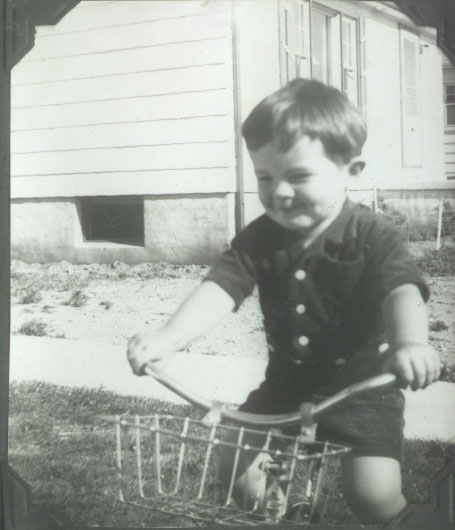
This photo and the one below were taken in front of our house at 206 Linwood Street, London, Ontario – I was quite young at the time and don’t recall the occasion, though I do seem quite pleased with my conveyance and resplendent with a jaunty riding outfit. I had one other toy I rode, likely at the same time, my red-metal wagon:
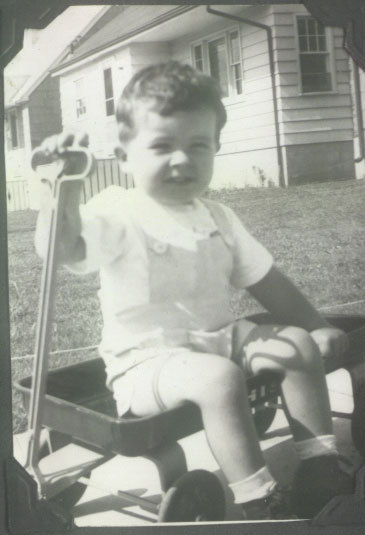
As with the tricycle, I have very little recollection of the wagon other than one relating to pulling it by the handle and a very evanescent body-memory of propelling it with one knee inside the wagon box, holding the handle in front of me to steer while pushing it scooter-like with my other foot and leg, all made possible by those stunning over-ankle boots I seem to be wearing. In the same vein, I have only one distinct memory of learning to ride Sandi’s (my sister’s) two-wheeler; it is of someone, likely my father pushing me along the sidewalk in front of our Byron Street (Trenton) home. Vaguely, I recall knowing the bike was too big for me and yet it seemed to serve my learning about the art of bicycle riding.
The Exeter bike and I became inseparable. Like most boys, I became adept at mounting the vehicle by grabbing the handlebars, putting my left foot on the left pedal, propelling the bike into forward motion with a right foot push-off, and then swinging my right leg up around the seat and over to catch the right pedal already in rotation from the direct chain drive. How many hundreds of times was that action repeated over my lifetime! As everyone did, I gave rides to friends sitting side-saddle on the cross-bar inclusive of my first girl friend, Jane; I can still feel my unbridled joy in riding with her seated sideways, her cheek at a right angle and so very close to my face. That bicycle was my means to freedom and I rode it everywhere, occasionally attaching half of a cigarette package with two clothespins to the back wheel frame such that the cardboard projected into the spokes. And it just might be that memory tricks me and I did the clothespin thing on my tricycle at an earlier age. Whatever the case, the resultant motor-sound enchanted every kid and foreshadowed, I perceive in hindsight, my love for motorcycles.
Once, unaware of the severity of impending weather on an extremely hot and humid Summer day, two of my friends and I decided to ride north on highway #4 to Hensall. I’m not sure why were going there, perhaps to get fresh peas from local harvests. At any rate, warm winds were howling and to my surprise, my dad pulled over in front of us in his ’54 Meteor. Apparently, there was a tornado warning! We had no idea. He was livid about our ‘stupidity’ and escorted us home where I suspect I was given a good tongue-lashing and had my bike ‘impounded’ for some period of time. Within a year of getting the bike, my father decided it was important for me to get a job, to earn my own money. At first, I delivered the Star Weekly, once a week and then a daily paper route became available with the Toronto Globe and Mail. Somewhere, likely at the Exeter Canadian Tire store, I purchased a very large front basket, something like this one, though not my actual bike or me…
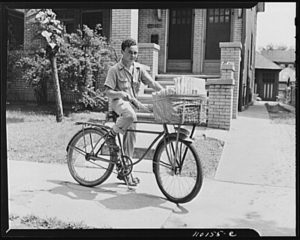
For two years, I got up at 6:00 am and waited in the Exeter town hall for the Globe delivery person who in my memory was always late in making the drive from Toronto, particularly in inclement winter weather. Other route carriers, for the London Free Press, I think, came and went before my newspaper bundle even arrived. Once the 40 or so papers were dropped on the hall steps, I brought them inside, cut the twine bundling the papers, and then folded the paper into in thirds by tucking the folded section into the opening on the spine side of the paper, like this:

I carried a single-strap, canvas Globe-embossed newspaper shoulder bag which I then filled and packed into the front basket. Fully-loaded, the bike rode precariously (a little personification there) until I became accustomed to the the front-ended weight. The very best part was riding my route, one which seemed to encircle the perimeter of the town, and flinging a folded newspaper onto each front porch, never leaving the bicycle seat – I regarded this feat as a challenge and an art-form, wary of missing the porch lest ticked-off subscribers became vexed and let me know their disgruntlement on collection day, every Saturday (before pre-paid subscriptions, I surmise).
If I had my bicycle when we moved from Exeter to London in 1962, I don’t remember riding it in my early high school years. By the end of grade 11, motorcycles had captured my imagination and interest (see my Zen..in cc’s blog) and riding a bicycle all but faded from my repertoire right through my university degrees’ years; I did have a second-hand single speed bike when I lived in Arnprior, near Ottawa while I was doing doctoral research. It was during my first 8-10 years as a professor at Western, starting in 1974 that bicycling was ushered back into my life in two distinct ways. First, we lived in north London, some 6 kilometres from the university. Only able to afford one car, I chose to purchase a 3-speed, sky-blue bicycle. 10-speed bikes were in existence – I even had a chance to buy into a 10-speed bike distribution company but just couldn’t imagine the reason one would need more than 3 gears and very likely, I didn’t have investment money. Shifting among the 3 gears entailed moving the pedals in reverse for one revolution to let the geared hub disengage and re-engage, I think. That action is not required on current 3-speed bikes.
I rode it year round, in all seasons for almost a decade, sporting a dark blue helmet for safety’s sake especially in winter. At the time, riding along Adelaide and Windermere roads was much less traffic-laden simply because the area was in the infancy of its development. Nervous and/or incredulous drivers would often honk at me when I rode in severe weather. I carried rain gear in my backpack and always had a change of clothing in my office at work. Before Western brokered a deal with the coffee chain, I can remember picking up a Tim Horton’s coffee at Masonville and putting it into a cup-holder I had rigged onto my handlebars. Either I was not as fussy as I am now about hot coffee or I nuked it before meeting my colleagues for early morning coffee time. As for the commute, for the most part, it was just a way of life. Each Spring, when I started to train for running marathons, the trip home was often fatigue-challenging especially in bad weather. I did pride myself in attempting to traverse the hill beside Mount St Joseph’s in 3rd gear the whole way, somehow feeling it would bolster my quadriceps for running.
By far the most alluring and the second of the manners in which bicycles came back into my adult life was through teaching sport history. I became absolutely smitten with bicycle history just about at the time Queen released Bicycle Race. My interest in cycling history was augmented by my late 1970s immersion in research leading toward the 1981 publication of my first book, A Sporting Evolution: The Montreal Amateur Athletic Association, 1881-1981:
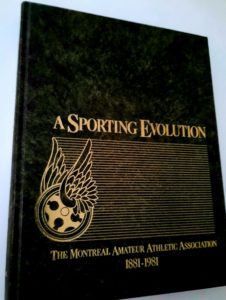
One of the 3 original clubs to form the prestigious MAAA was the Montreal Bicycle Club, the latter established in 1878. The Winged Wheel became the symbol of the MAAA, likely in a mirrored tribute to the more established Winged Foot symbol incorporated by the famed New York Athletic Club (established in 1868). The wheel in the winged symbol reflected the significance attached to the bicycle club. It was in the carefully preserved, archival material owned by the MAAA that I became aware of the pictures and history of the bicycle and what it meant to late nineteenth century society, in Canada and throughout the western world.
The original ‘bicycle’ was a ‘hobby-horse’ pictured in this caricature from the mid-19th Century…
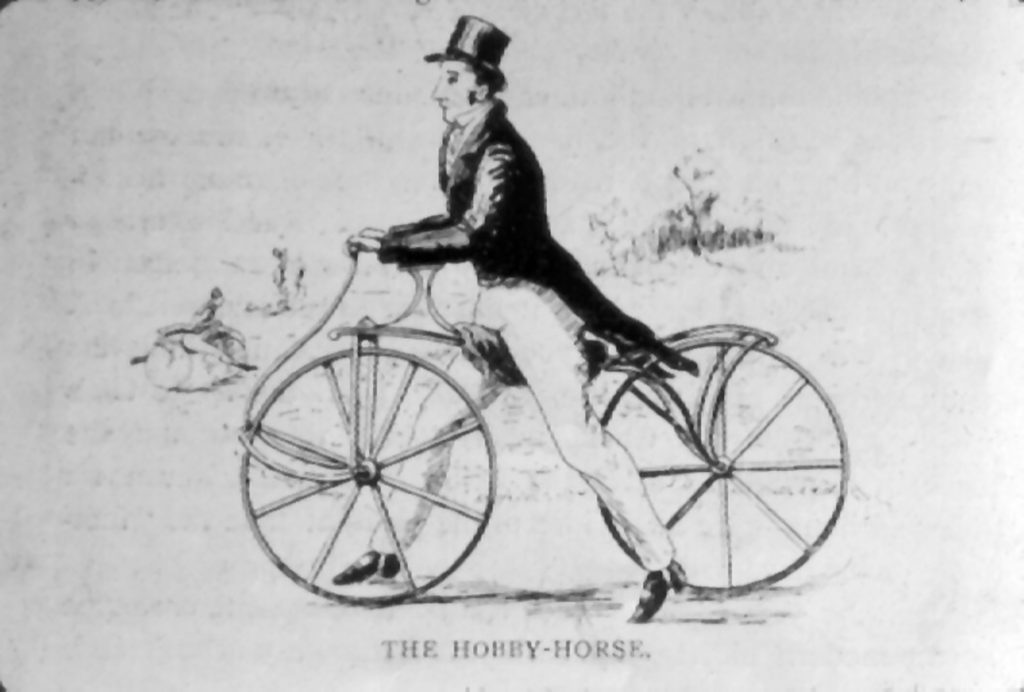
It was aptly named, very likely replicating the saddle body-positioning needed to ride a horse and doing so for sheer recreation, as a hobby. The earliest of these machines were ridden by the elite members of French and British society, gently satirized by the presses of the day with projected riding schools and country sojourns:
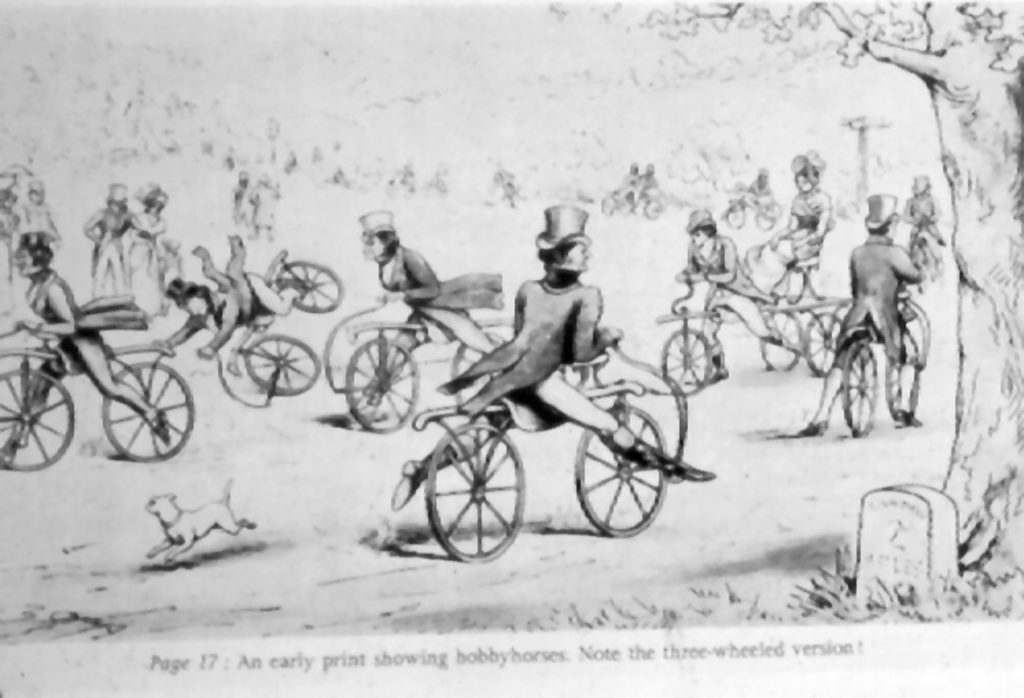
Complete with top-hats, these early riders were hailed as “dandies” for their penchant for riding and doing so in high-style outfits. Of note in the image above is the milestone in the bottom right corner. Common roads were marked with stones set at mile-markers in descending numbers toward the next town, city, or village. The hobby horse itself was likely expensive, had no pedals or brakes and was propelled solely by alternate foot-strides. Roads were dirt-packed and abysmal by any standard so riding must have taken considerable effort, devotion, and imagination. Estate gardeners were said to use the hobby horse to patrol and tend their grounds.
Curiously, what literally and figuratively revolutionized cycling was the invention of the ‘penny-farthing’ bicycle – so named for British coin currency with the farthing being the smaller of the two coins such that penny was the front wheel, farthing the rear one – sometime in the early to mid 1860s. By 1870, the farthing or high wheeler looked like this:
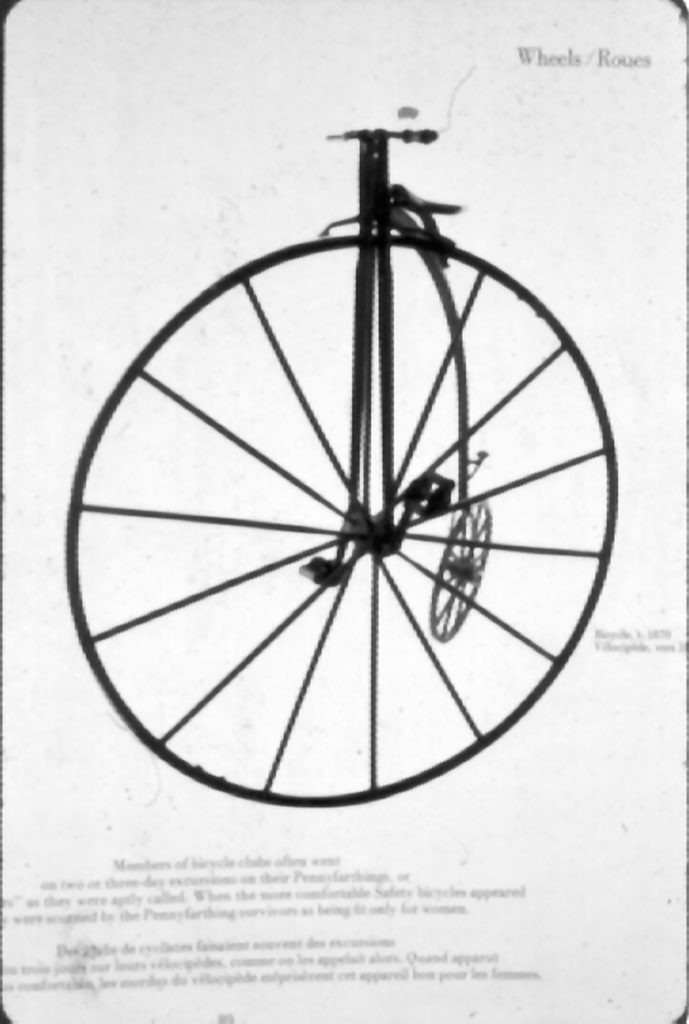
It was made of solid steel and very heavy. If the wheels had tires, they were of solid rubber lining the outer rim of the wheels. For good reason then, these bikes often were termed ‘boneshakers’ – such an apt encapsulation of what riding one must have felt like. Where the hobby horse had wheels of equal size and looked like our modern notion of a bicycle, the idea behind the high wheeler was one of assumed mechanical advantage. The pedals were affixed to the hub of the large front wheel, the diameter of which was about 48 to 53 inches (122 to 135 cm). The rider was seated over the front wheel. Pedals were direct-drive, like a tricycle, that is, if the bike were in motion, the pedals moved with the revolutions of the front wheel. Once on the vehicle, riding was easy; the tricks were in the mount and dismount. To get on the bike, there was a small projection on the frame near the farthing or back wheel. In the image above, that little step can be seen at about 2 o’clock through the spokes of the front or penny wheel. Gripping the handle-bars, one’s left foot on the projection, the rider gave 4 or 5 good thrusts of the right foot until enough momentum was achieved to swing the right leg over the drop-frame up onto the seat and then catch the pedals, already in motion. This awkward-looking and yet stable mounting method is shown below:
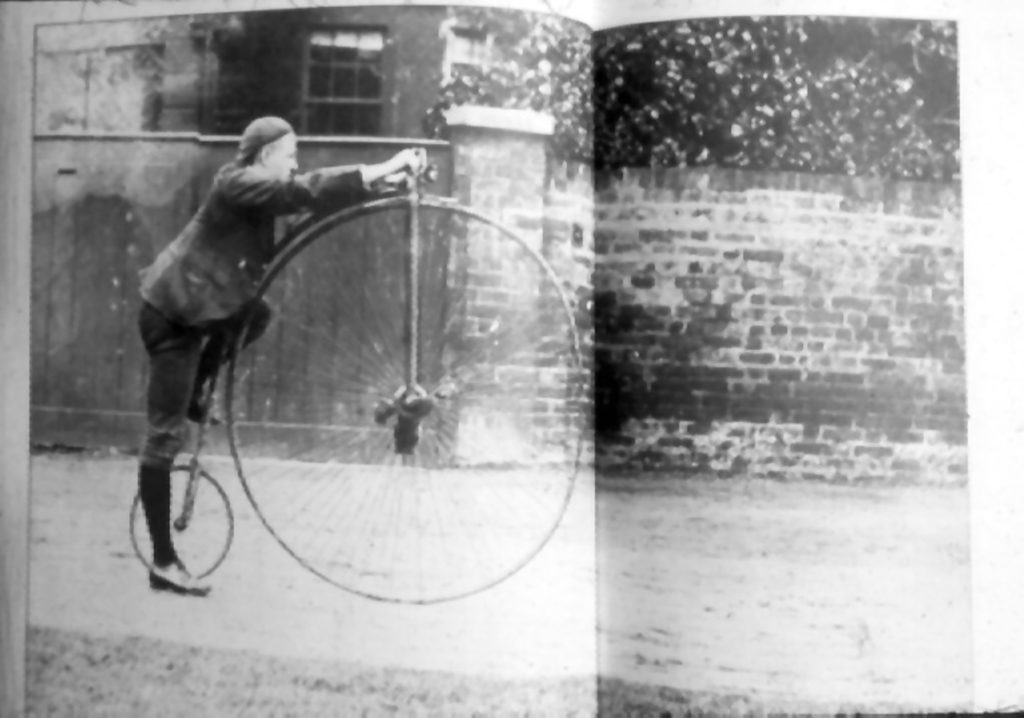
Once moving, the concept was it took less effort, less revolutions of the pedals to move the large circumference of the penny-front wheel over terrain than it would for a smaller-sized wheel – a great reat theory especially given the lack of smooth riding surfaces in the late 19th Century.
Bicycle clubs formed readily in the late 19th Century; one of the earliest and most famous was the aforementioned Montreal Bicycle Club photographed in 1885 (below) in the famed Notman Studios:
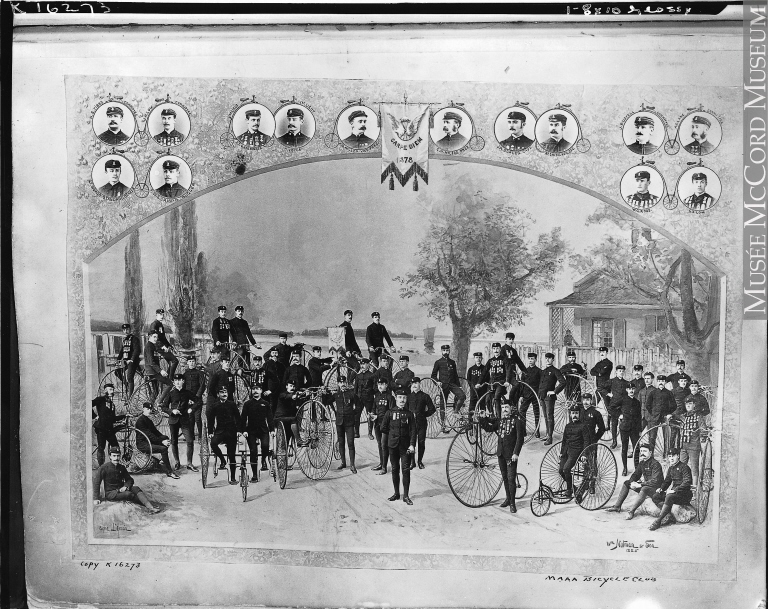
More will be shared about the bicycle variations in this image later in the blog. Getting off the high wheeler required good balance and great judgment. For a long time, the farthing had no brakes although there were some fanciful ideas like this one where the rider just leaned back on the seat to push a fixed piece of metal onto the back wheel rim:
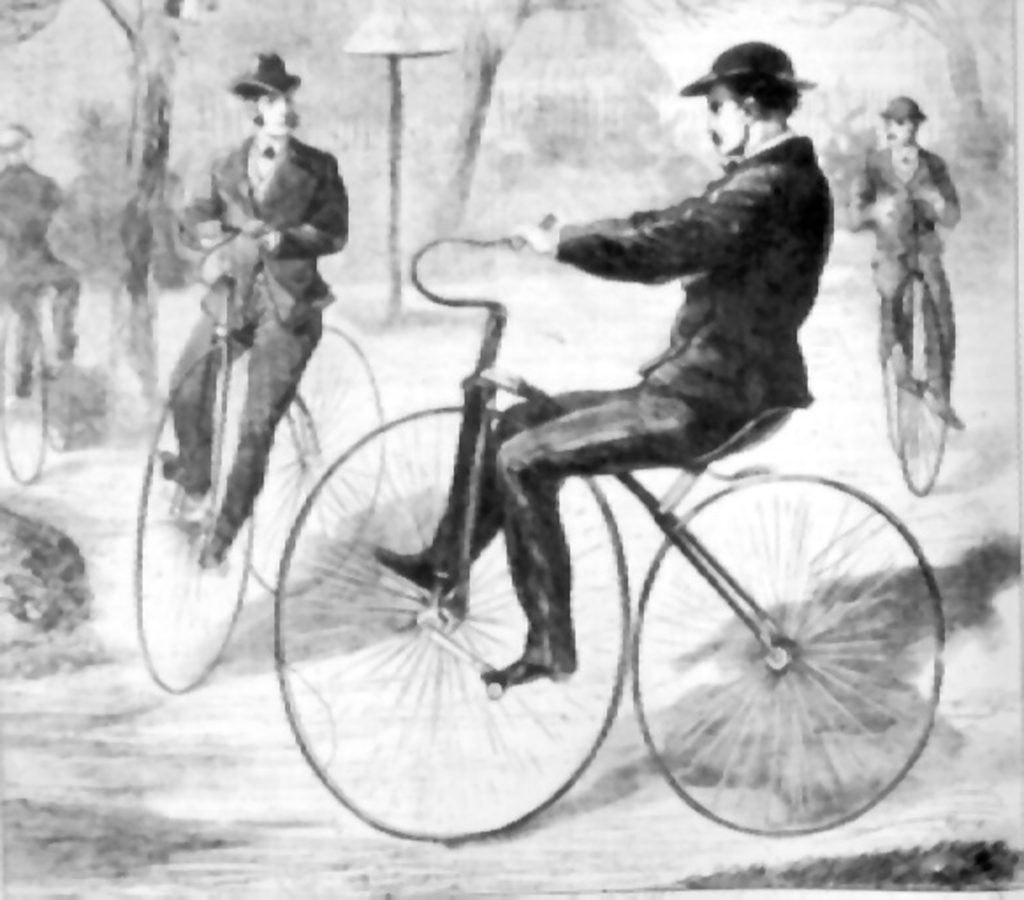
I never saw this brake-invention in any other pictures but if utilized, one can only imagine what happened when riders went over a bump or in precarious conditions, inadvertently applied enough pressure to the back wheel to cause the vehicle to skid. Nevertheless, the farthing dismount was accomplished by slowing the bike’s rate of speed then timing the pedal on say, the left side such that just as the pedal reached its highest point, the rider put all their weight on that pedal while simultaneously swinging the opposite leg up and around the seat as the left pedal continued downward and then stepping off the bike on its left side just as the pedal reached its nadir point. The other option to getting off the high wheeler was this one…
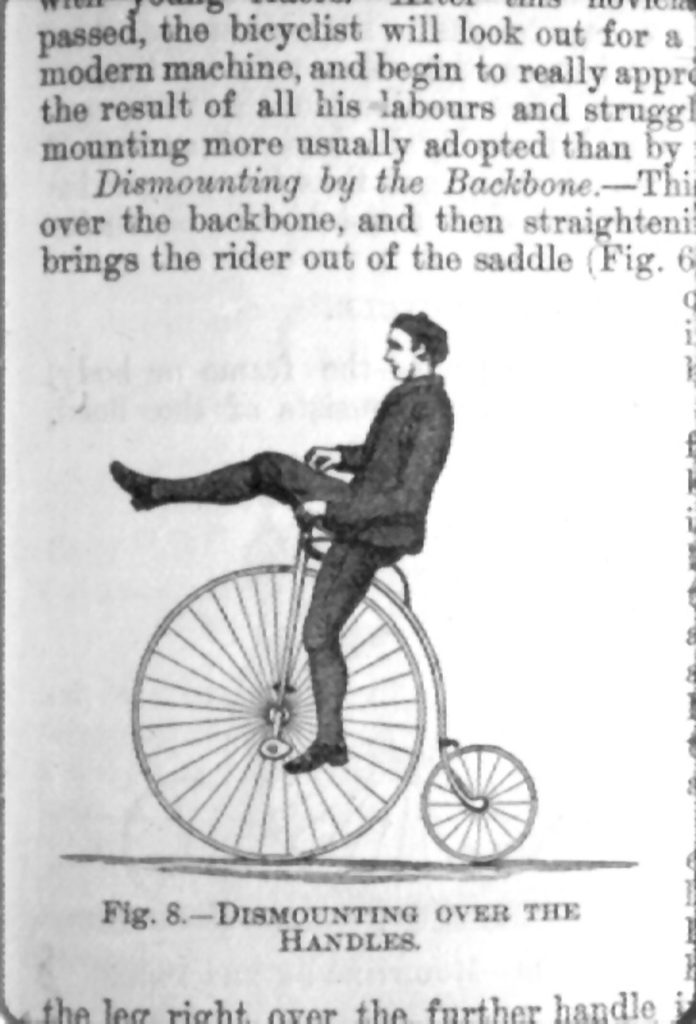
And I can’t fathom the timing issues required with the pedal or, as the photo implies, kind of leaning to the left without using the pedal at all, rather touching down with both feet at the same time. The recommended downhill riding position was this…
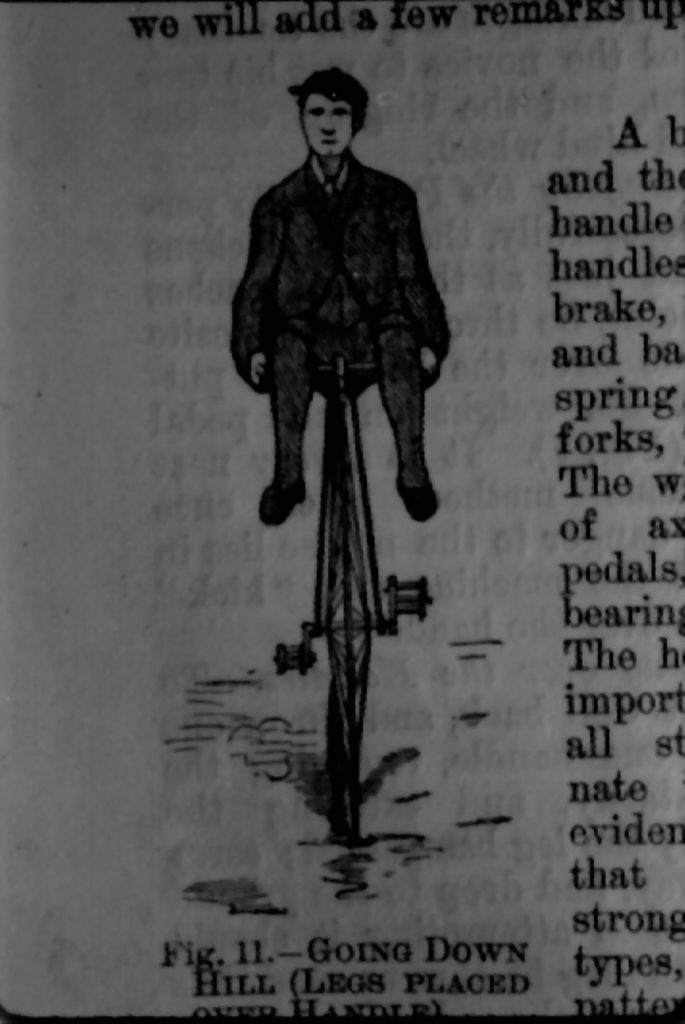
As bicycle magazines, books, and manuals would have us believe, this technique was particularly useful for downhill riding – one could coast thereby avoiding having to keep up with the increasing speed of the ever-revolving pedals and should the bike tip forward, all one had to do was kind of fall forward as the lighter, farthing wheel came up toward the rider’s back. This whimsical idea reminds me of the equally capricious concept of what to do to avoid injury in a plunging elevator; at the last minute, just before the elevator crashes, jump up to avoid the collision. The most threatening and prevalent injury in riding the farthing was the dreaded header or cropper where the rider hit a bump and was propelled over the handlebars as illustrated in this playful caricature of a rider encountering sheep on the road:
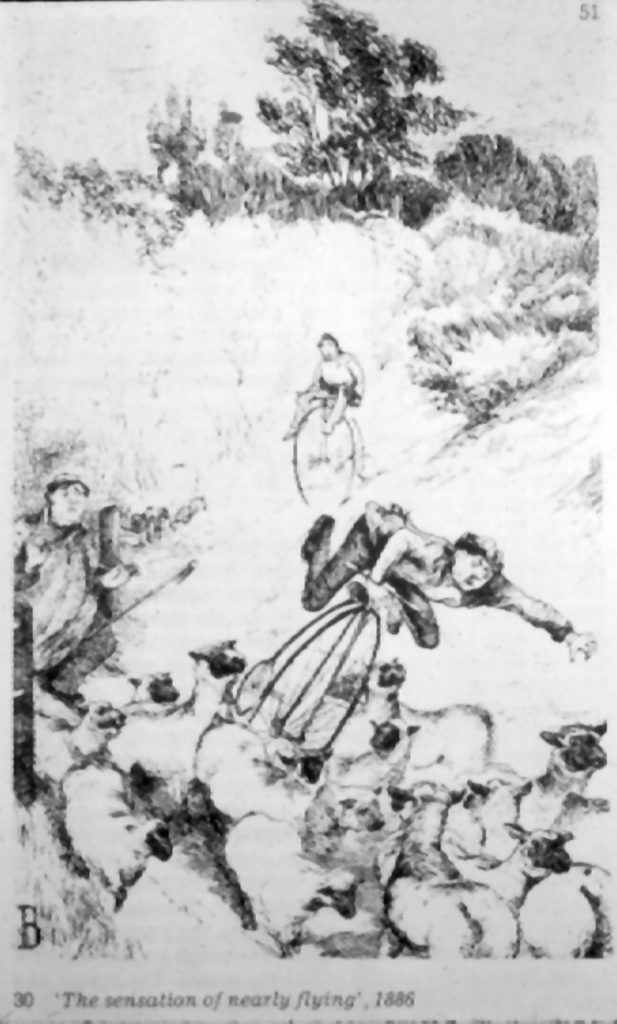
Incidences like these must have occurred frequently; some say the whole vehicle insurance industry was created because of the bicycle and its attendant dangers and mishaps.
By the mid 1980s, my interest in bicycle history had escalated such that I sought to acquire a penny farthing. I had no idea where one would obtain such a thing and I assumed it would be 100 years old and preserved because of its steel structure. To my surprise and delight, I found a company in Oakland California, ‘Rideable Replicas.’ After a multitude of inquiries, in 1985 – one hundred years exactly from the date of the famed Montreal Bicycle Club Notman portrait provided earlier – the connection was not lost on me – I bought a replica penny farthing for $350 US and had it shipped to London. It was steel-framed, the rims encircled by hard rubber tires, and it came equipped with a bell and a hand-brake lever on the handlebar that was attached to brake pads on the back wheel. This was one of my first rides on my new bike:
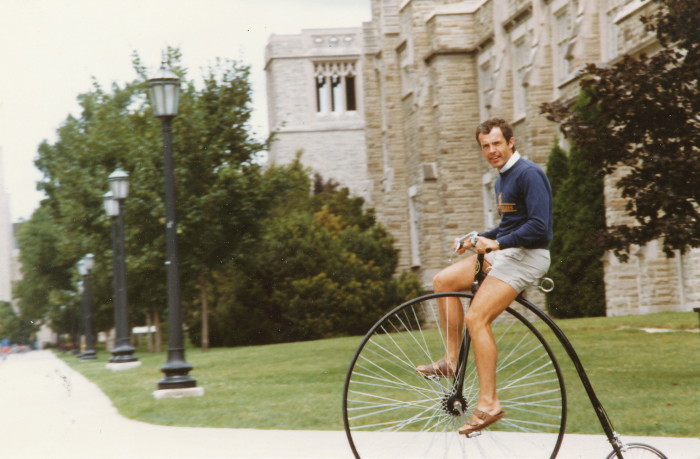
Under my butt, you can see a huge spring mounted under the saddle or seat; I doubt the original bikes had such a comfort feature. And just above the rear wheel adjacent to the frame is the barely visible brake mechanism. The farthing did not stop with the brake but with enough pressure, it did help to slow the machine down for dismounting. In passing, in the picture I am riding outside my Western office building, Thames Hall; my office window – at least the last office of 17 offices I occupied during my career – is just above the sill behind the back of my head. I rode around the traffic circle in an era of much less congested pedestrian and vehicular traffic than today. Slightly discernible on my chest is the embossed winged wheel emblem of the MAAA, a sweatshirt I acquired from the centennial celebrations of that club in 1981; it seemed only fitting my first ride should pay tribute to the Montreal Bicycle Club.
My omnipresent desire in teaching students about sport history was to bring the past to life, make it meaningful for students. It was axiomatic then that I would teach about bicycle history and then have them ‘ride history’ on my new farthing. At first, I used the same traffic circle as in the image above; however, a safer venue was the J.W. Little Stadium track a few hundred meters from my office. On the advice of my Faculty’s administrators, I required each student who wanted to ride the machine to sign a waiver in at least a token effort to avoid legal issues should a student injure themselves:
24 January 2008
WAIVER FOR RIDING THE HIGH-WHEELER BICYCLE
I AM AWARE THAT RIDING THE HIGH-WHEELER BICYCLE IS COMPLETELY VOLUNTARY AND THAT IT INVOLVES SOME RISK OF INJURY. IN CONSIDERATION OF BEING OFFERED THE OPPORTUNITY TO RIDE THE HIGH-WHEELER BICYCLE, I HEREBY EXPRESSLY ASSUME SUCH RISK, AND RELEASE AND DISCHARGE THE UNIVERSITY, ITS STAFF/FACULTY, EMPLOYEES, SERVANTS AND AGENTS FROM ALL CLAIMS FOR INJURY OR DAMAGES SUFFERED BY ME BY REASON OF MY RIDING THE BICYCLE, NEGLIGENCE OF ITS USE OR SUPERVISION OR LACK OF ITS MAINTENANCE, HEREBY AGREEING TO FOREGO ALL LEGAL CLAIMS WHICH I MAY HAVE RESPECTING SUCH MATTERS:
No one ever did hurt themselves in some 20+ years of doing this on an annual basis. If my course were offered in the Winter, then we used the Thames Hall gymnasium back-dropped in this 2008 photo:
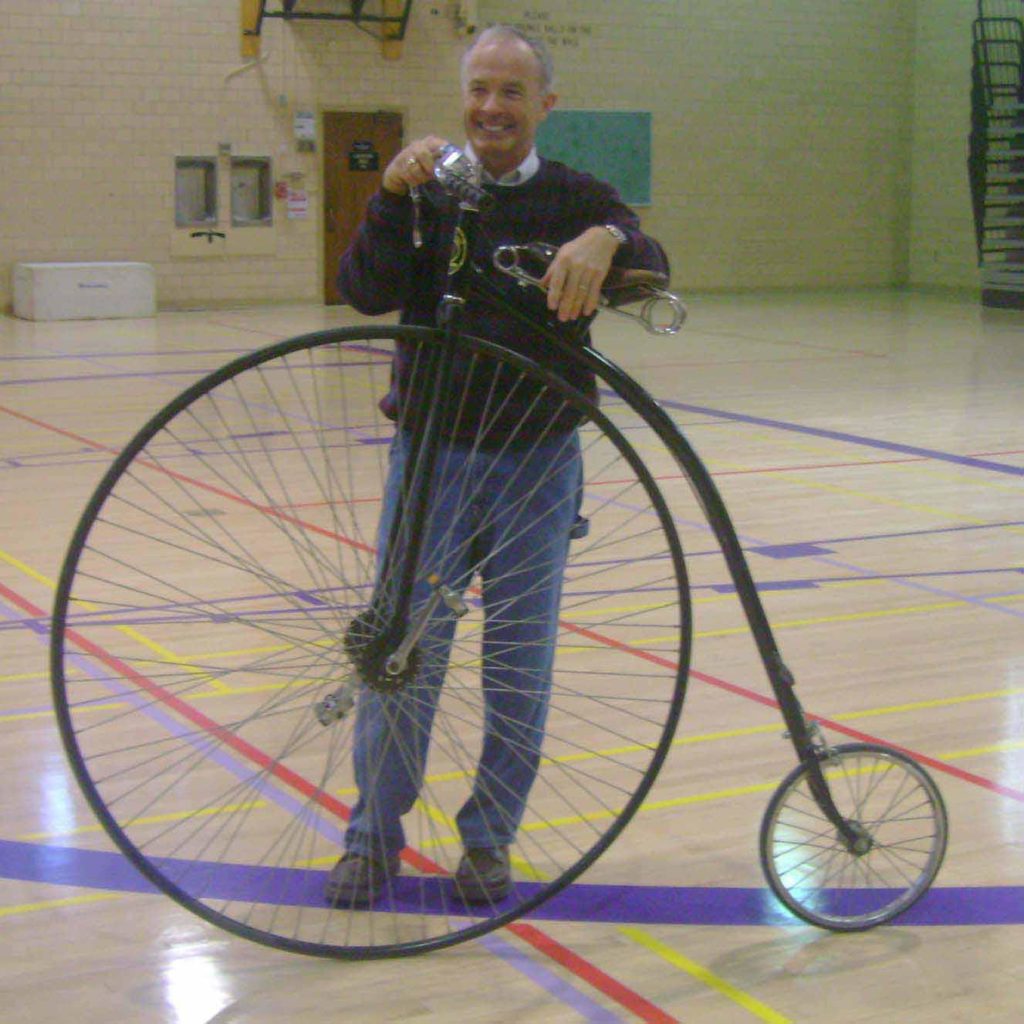 I show this photo to point out the relative size of the front wheel, about 4 feet. What we discovered with students and friends who tried to ride it is that if one were shorter than about 5 feet, 6 inches, then that person could not maintain contact with the pedals throughout the full pedal revolution. Instead, shorter individuals had to push-pedal by alternate thrusting of each pedal at the apex of its arc – kudos to those who did so! And I always offered the option of allowing prospective riders to mount the bike on its own, or, I would straddle the front wheel and hold the front of the handlebars while the rider stepped onto the rear foot-brace and up onto the saddle. Then I would grab the bar behind the seat and push the bike until it had enough momentum for them not to fall and continue by pedalling. Instead of trying to dismount on their own, I encouraged them to ride slowly toward me, maintaining their pedal motion and I would catch the front of the handlebars and ease the bike and rider to a full stop thereby allowing the person to get off with the bike while stable and at a standstill. I remember one year, a gymnast (I later discovered) chose to dismount by putting all their body-weight on their hands while holding the handlebars and then vaulting off the bike in one motion. While it worked for that student, they almost re-created the dreaded 19th Century cropper when the back wheel came up well off the surface with all the gymnast’s weight transferred over the front wheel.
I show this photo to point out the relative size of the front wheel, about 4 feet. What we discovered with students and friends who tried to ride it is that if one were shorter than about 5 feet, 6 inches, then that person could not maintain contact with the pedals throughout the full pedal revolution. Instead, shorter individuals had to push-pedal by alternate thrusting of each pedal at the apex of its arc – kudos to those who did so! And I always offered the option of allowing prospective riders to mount the bike on its own, or, I would straddle the front wheel and hold the front of the handlebars while the rider stepped onto the rear foot-brace and up onto the saddle. Then I would grab the bar behind the seat and push the bike until it had enough momentum for them not to fall and continue by pedalling. Instead of trying to dismount on their own, I encouraged them to ride slowly toward me, maintaining their pedal motion and I would catch the front of the handlebars and ease the bike and rider to a full stop thereby allowing the person to get off with the bike while stable and at a standstill. I remember one year, a gymnast (I later discovered) chose to dismount by putting all their body-weight on their hands while holding the handlebars and then vaulting off the bike in one motion. While it worked for that student, they almost re-created the dreaded 19th Century cropper when the back wheel came up well off the surface with all the gymnast’s weight transferred over the front wheel.
Always I demonstrated how to ride it, not to show off but to assure students even their prof could ride it safely:
This was in the same gym as in the picture above and the video was taken on a student’s phone, unbeknownst to me at the time. Not revealed in the image above the video and in the video itself is that I am wearing coveralls (you can see the hammer-hanger loop on the side of my left thigh), garb that harkens back to my youthful wagon-riding outfit (see image at the start of this blog).
For myself, for a few years, I rode the bike in parades and even to/from work a few times; however, the latter I found dangerous not just for the stopping, dismounting, and re-mounting frequently required at stop signs, traffic lights etc but more that cars and pedestrians seemed to have two distinct reactions to seeing the farthing and its rider. Either they ignored it/me, perhaps not even wanting to guess the reason someone would have such an odd bike, or, more often, drivers would fixate on the bike and inadvertently steer toward me. Similarly, people who were walking wanted me to stop so they could see it and talk about it. I decided it was best not to use the vehicle for commuting.Recently, Paul Gauthier, a Montreal resident discovered that you could order farthing ride-able replicas and did so. He too became enamoured with the machine and currently promotes a Montreal Boneshaker club. In this piece about his Montreal riding exploits, Gauthier demonstrates that an early, 1897 road map of the city was actually a bicycle map owing to the presence of bikes that antedated automobiles – see the map video here.
Riding the farthing in class did create a deeper appreciation of living history. Indeed in its heydays of the last third of the 19th Century, this boneshaker spawned so much romanticism and so many inventive variations. In the former regard, consider this image
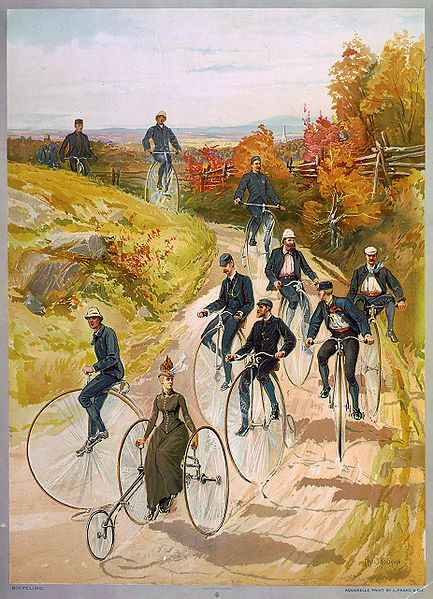
Very likely, this is a hand-painted lithograph. Notice the pastoral, autumnal countryside, the riding outfits, the close-formation of riders, and especially, the tricycle adaptation piloted by a woman in full skirts. More will be described about the impact of the bicycle on women’s dress reform. Uniforms for riding seemed to be important to 19th Century cyclists:
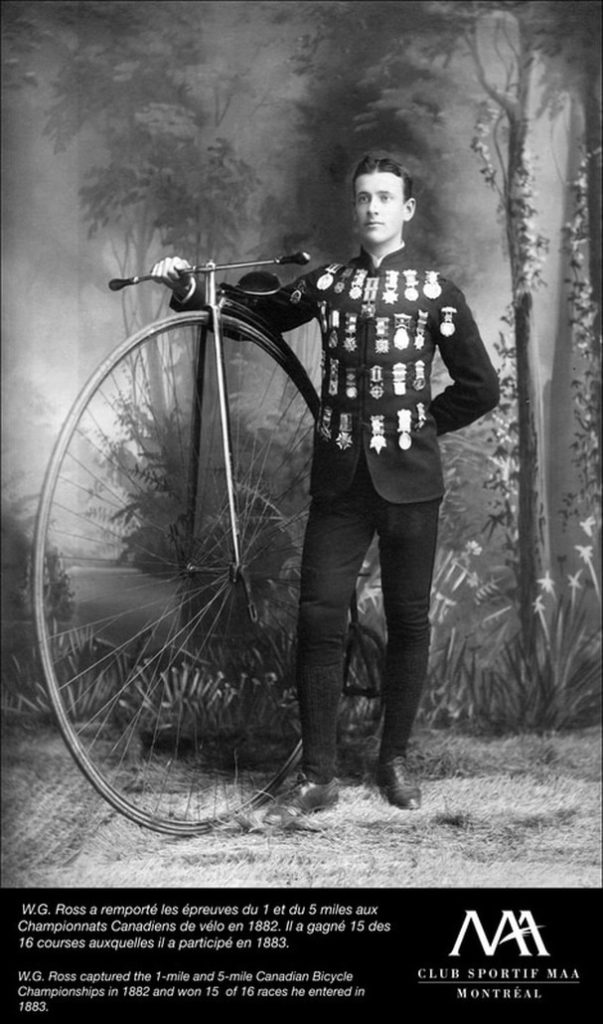
This is W.G. Ross, MAAA member and 1882 “Canadian” racing champion at 1- and 5-mile distances. Clearly, this mode of transport converted very quickly into a competitive implement in the spirit of what I used to teach as the axiom, if it moves, why not race it. Notice the para-militaristic medals pinned to Ross’ jacket, each and all indicative of his racing achievements.
Cycling and bicycles seemed to entice the Victorian imagination and developments and variations abounded very quickly. As if balance and croppers were issues, early multi-wheeled bikes like this one were invented:
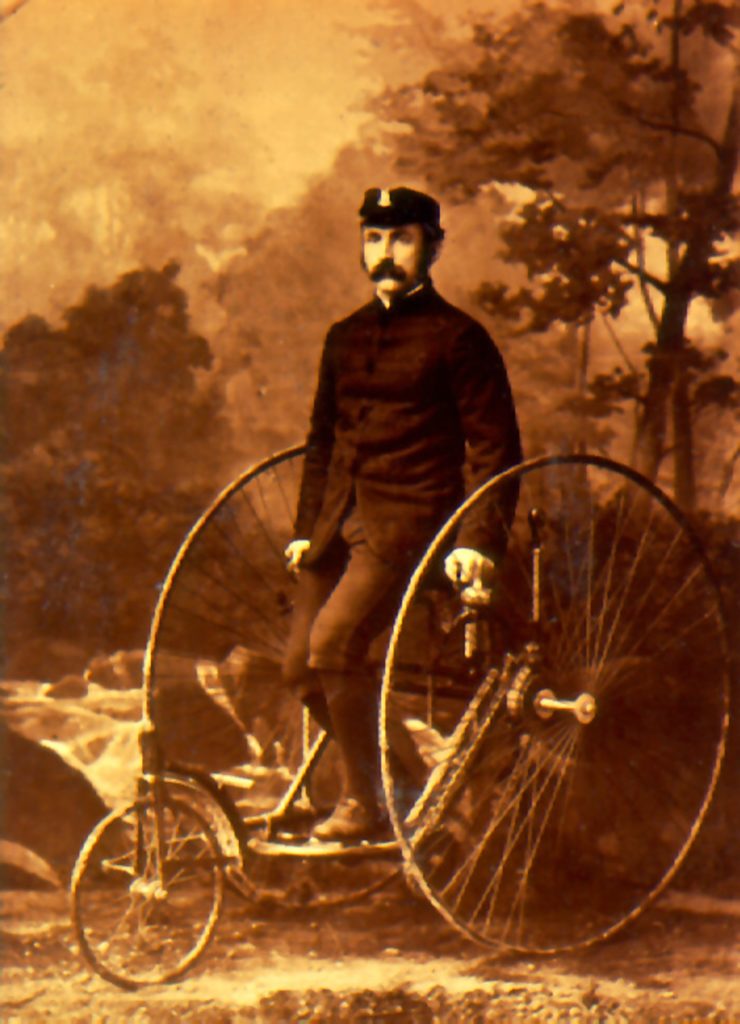
This is either a modified tricycle or there might even have been a very small back wheel converting the machine into a quadricycle. Note the elaborate steering mechanism and the pedals attached to what appears to be a chain drive to the left large wheel. It might have been that the rider could stand or sit. Variations of this bike style can be seen in the 1885 Montreal Bicycle Club picture earlier in this blog. Some fanciful ideas were very likely more honoured for their conceptual innovation than any realization in practical use. Consider the 1839 “Aellopodes” …
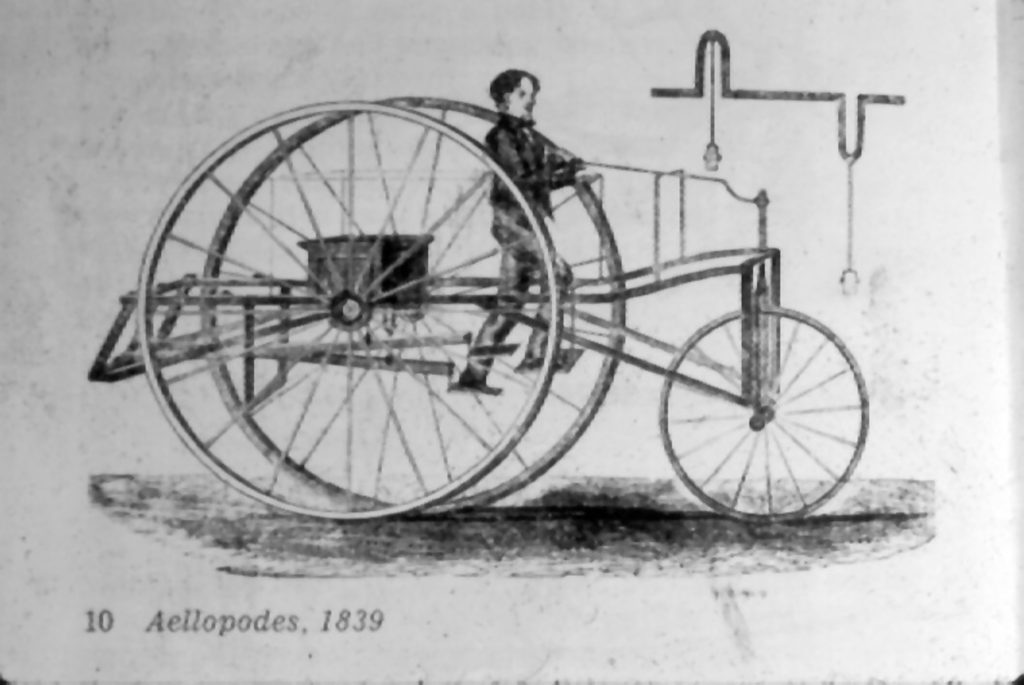
Quite a concept as was this (below) wagon-like vehicle that looks as though two of the riders are using a rowing device to propel the machine:
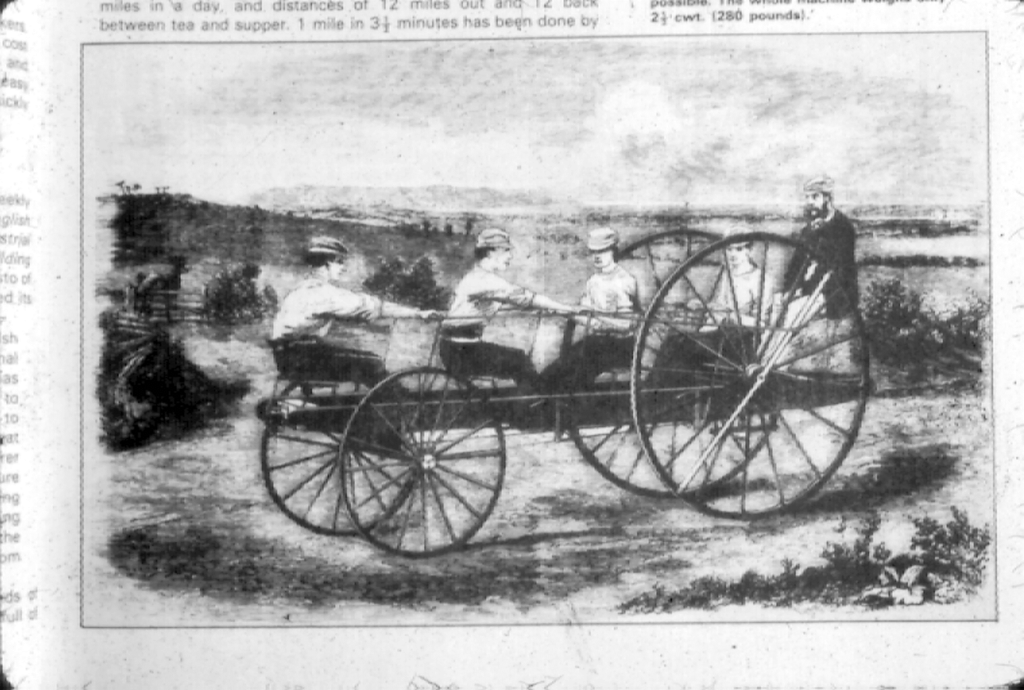
Of all the bicycle modifications, tandem bikcs and the sociable tricycle seemed to be the ones that gained most favour. This is one of the earliest, rear-steering tandem tricycle:
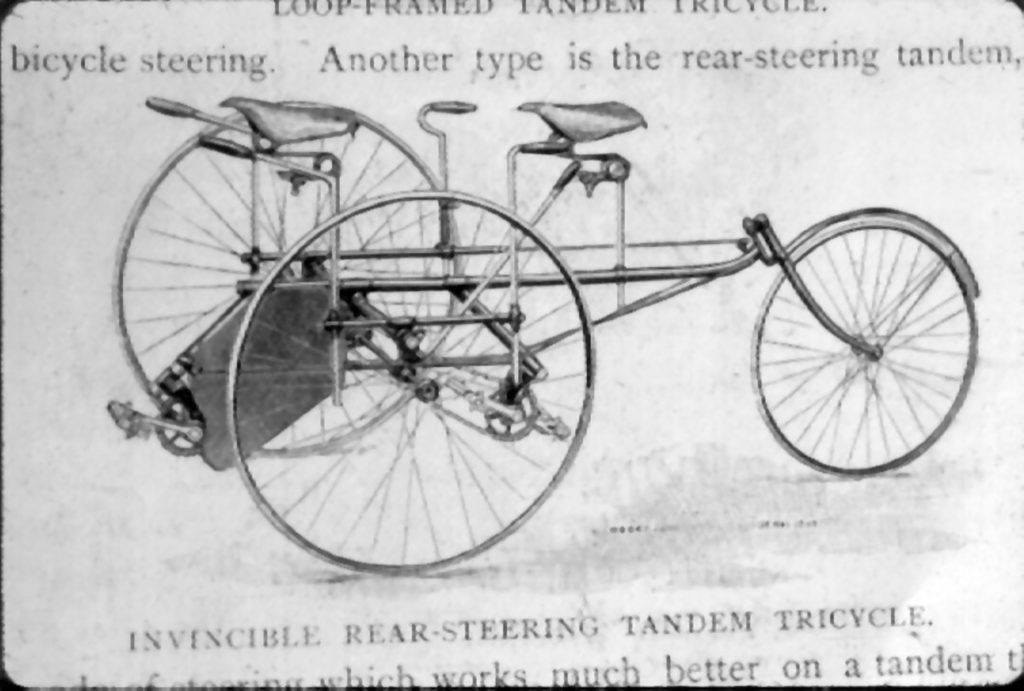
Likely the rider seated at the front (left saddle) controlled the steering of the back wheel. And there seems to be both a brake lever visible beside the rear saddle as well as a chain drive from the rear pedals to the front wheel. There were more practical uses applied to the bicycle, newspaper delivery for one depicted in London, England…
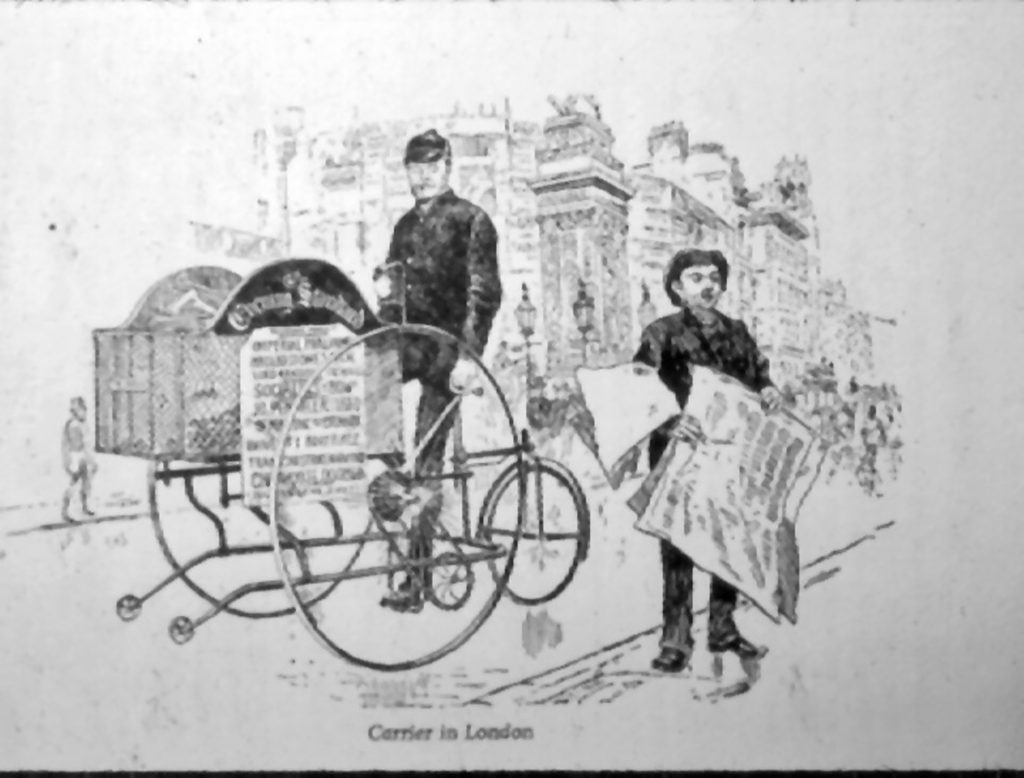
Other ideas likely were sketched but never realized, like these ones . . .
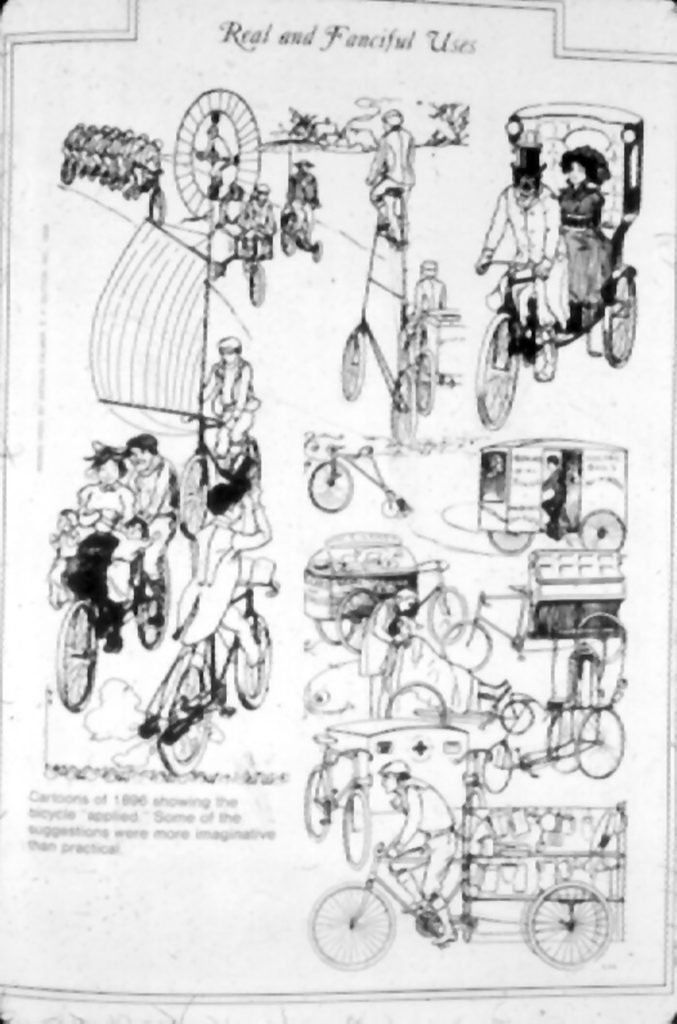
And one of my favourite fanciful bike caricatures, the family vehicle satirized by famed British cartoonist, Puck:
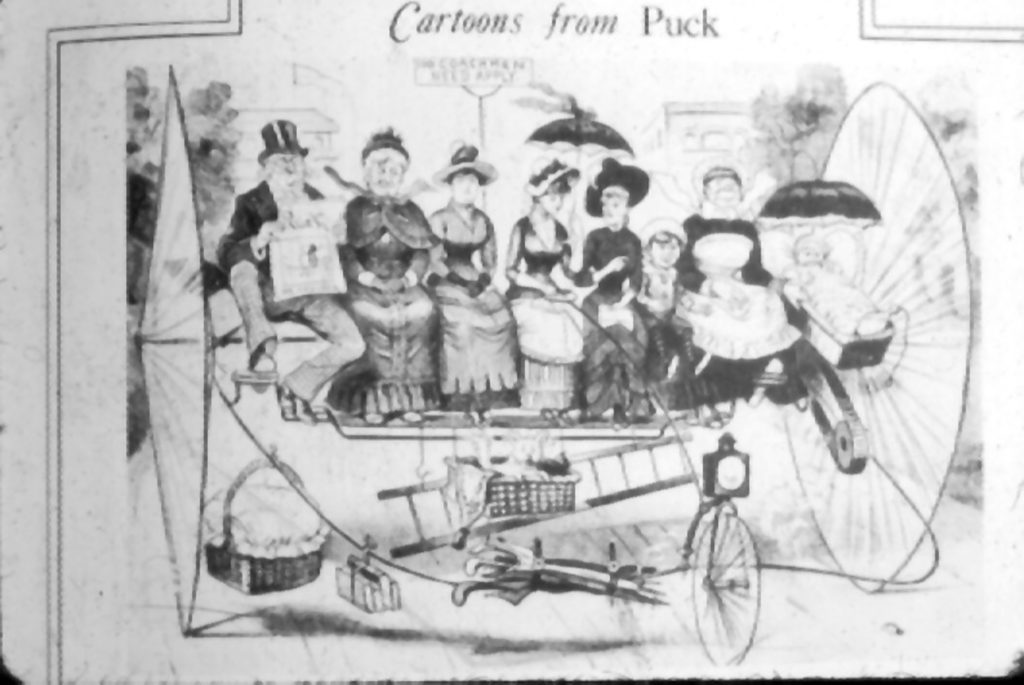
One of the most coveted of all the bicycle variations was The Sociable Tricycle:
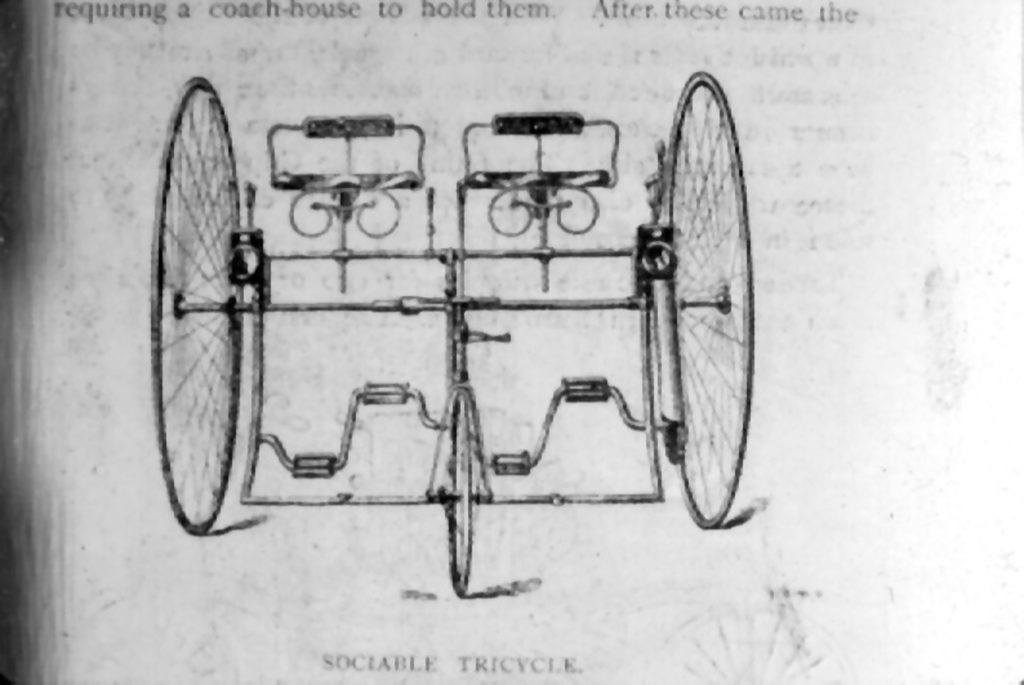
Modelled, no doubt on the horse-and-buggy carriage of the era, the ‘sociable’ implications are readily apparent:
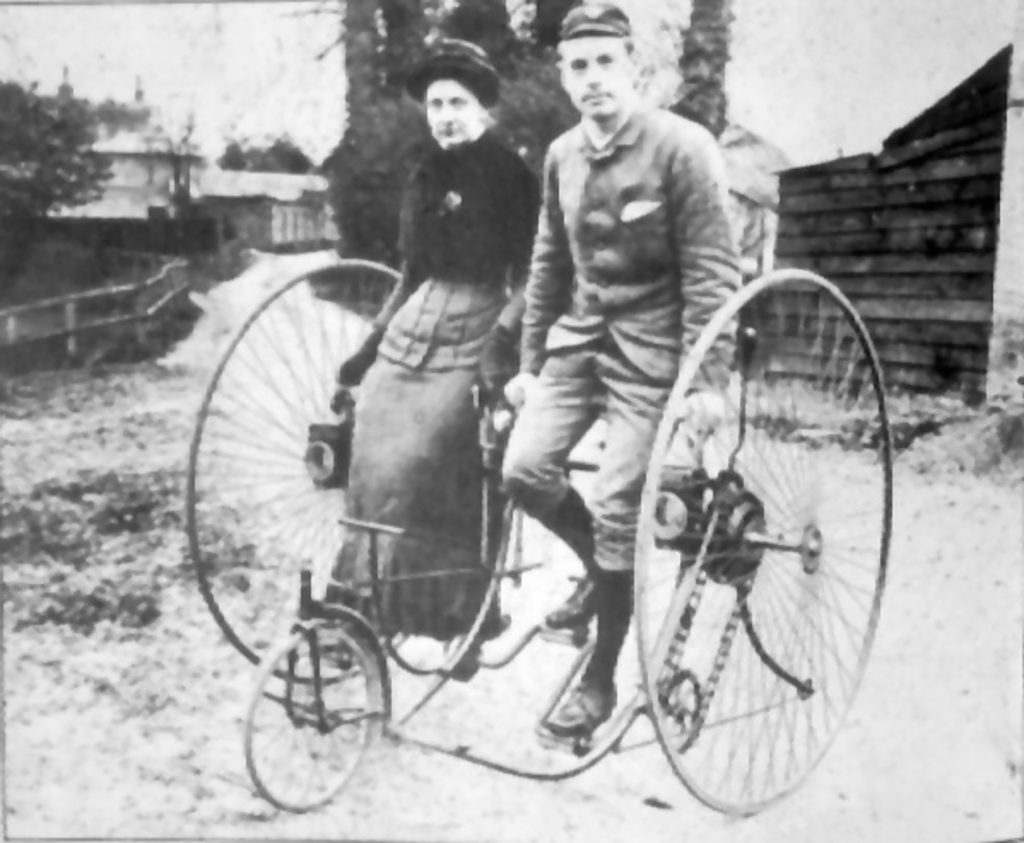
So immediately popular were these bikes that a cigarette company used the allure of the sociable to advertise its product and thereby be associated with the joys of wheeling.
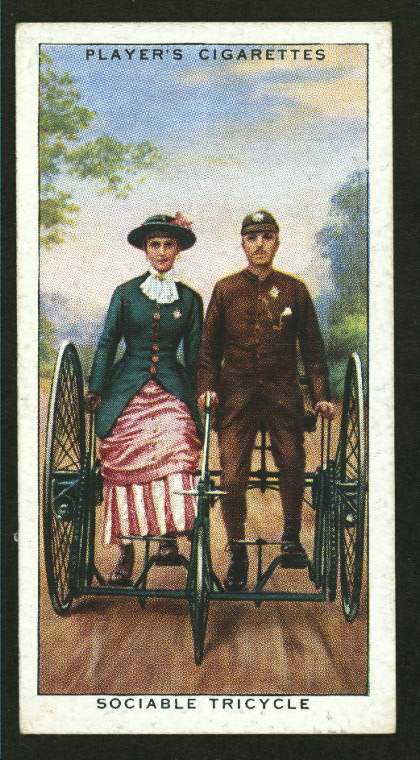
One can imagine in Victorian society with its often Puritanical morality, that chaperones must have been a prerequisite, presumably astride their own vehicle, for any outing undertaken by members of the opposite sex. What really ingrained and popularized the Sociable was Henry Dacre’s 1892 song, Daisy Bell, the first few verses and refrain for which are these:
Daisy, Daisy
Planted one day by a glancing dart
Planted by Daisy Bell
Whether she loves me or loves me not
Sometimes it’s hard to tell
Yet I am longing to share the lot
A beautiful Daisy Bell
I’m half crazy all for the love of you
It won’t be a stylish marriage
I can’t afford a carriage
But you’ll look sweet upon the seat
Of a bicycle built for two
Daisy, Daisy
Peddling away down the road of life
I and my Daisy Bell
A modern rendition of the full version can be heard at this link.
Out of all the repercussions of the invention of the bicycle and all of its adaptations, perhaps the most intriguing one is that of women riding the machines, the social implications of this gendered transition, and the sheer emancipation, almost literally, that the bike afforded women. Recall that the height of the front wheel might have precluded a lot of women from riding the high wheeler. That said, I did see one image of a woman seated side-saddle on a farthing with her feet resting on a projection from the frame. Presumably, she coasted on the bike. Interesting in terms of its gender implications, some of the very early pedalling mechanisms were derived from sewing machine treadles . . .
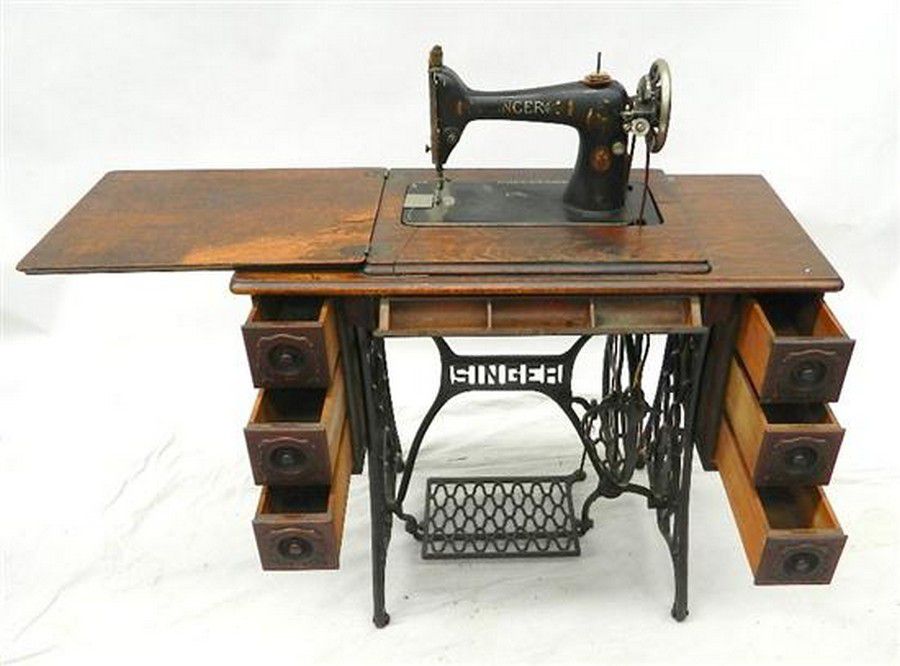
My grandmother had one exactly like this Singer model from the 1890s; I remember the little drawers in particular. The treadle is the foot-platform, metal device at the bottom, below the “Singer” brand name. The operator would use one or both feet on the treadle which was connected to wheels and belts that turned the sewing machine wheel on the top right and thereby moved the needle and thread through the material. It is not difficult to imagine the concept of transposing the belts and wheels to the bicycle driving mechanisms. In fact, the Singer company did manufacture bicycles for many years.
A major contributor to the prominent use of the bicycle among western women was the invention of the “safety,” that is a bicycle of equal-sized wheels. The name safety was affixed to the more modern style from all of the accidents and dangers inherent in riding penny farthings. Here is a very early safety:
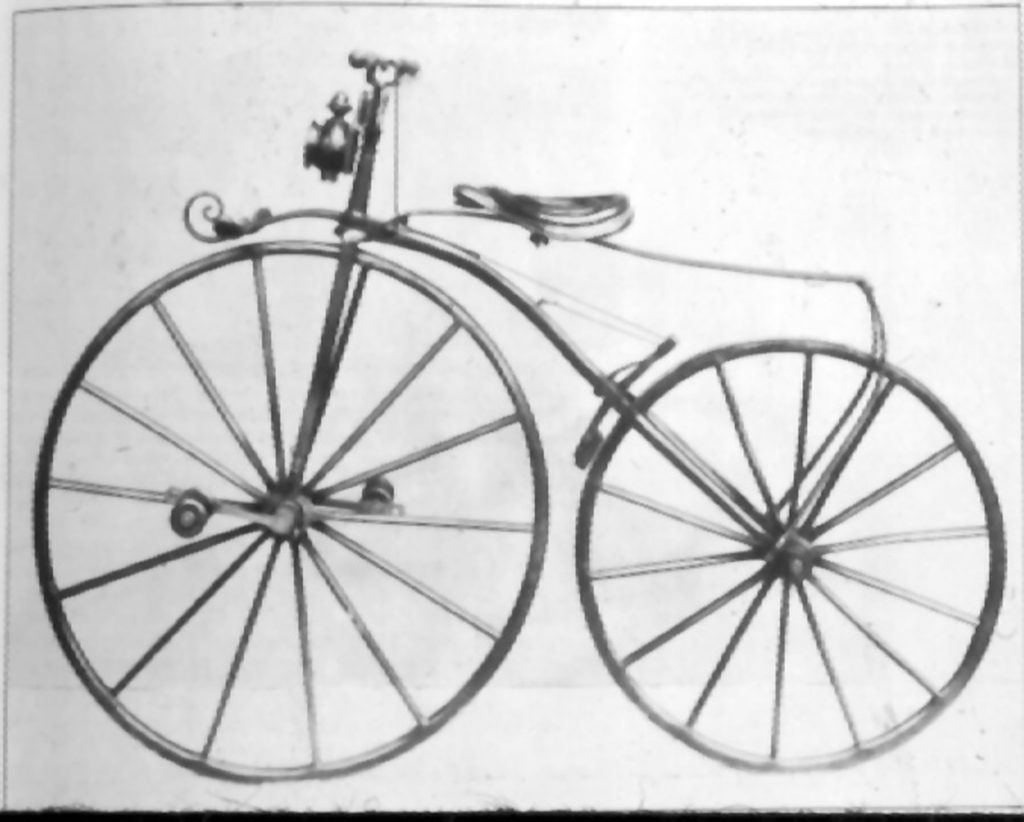
Note the light, the braking mechanism, and even a front fender of some kind. One model actually reversed the farthing wheel sizes…
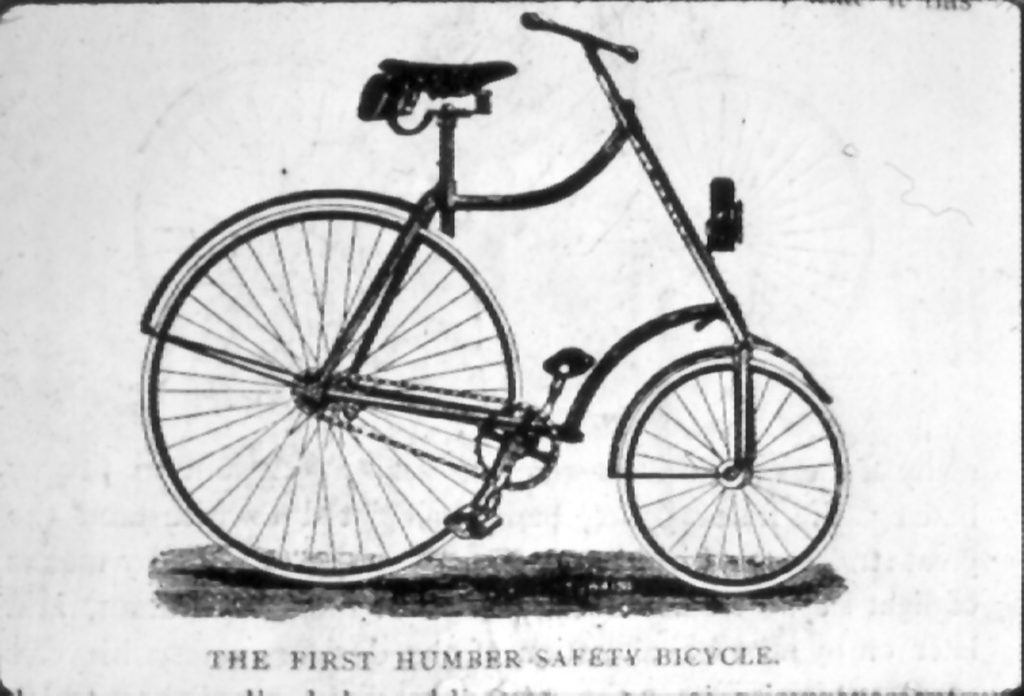
This “Humber” version, I believe, was made in Canada. Note both fenders, rear-wheel drive, the saddle bag, and front forks that were angled for ergonomic ease of steering. For women, such changes meant instant accessibility, even if full-skirted. Very likely some women, probably from the upper classes did have access to the hobby horse…
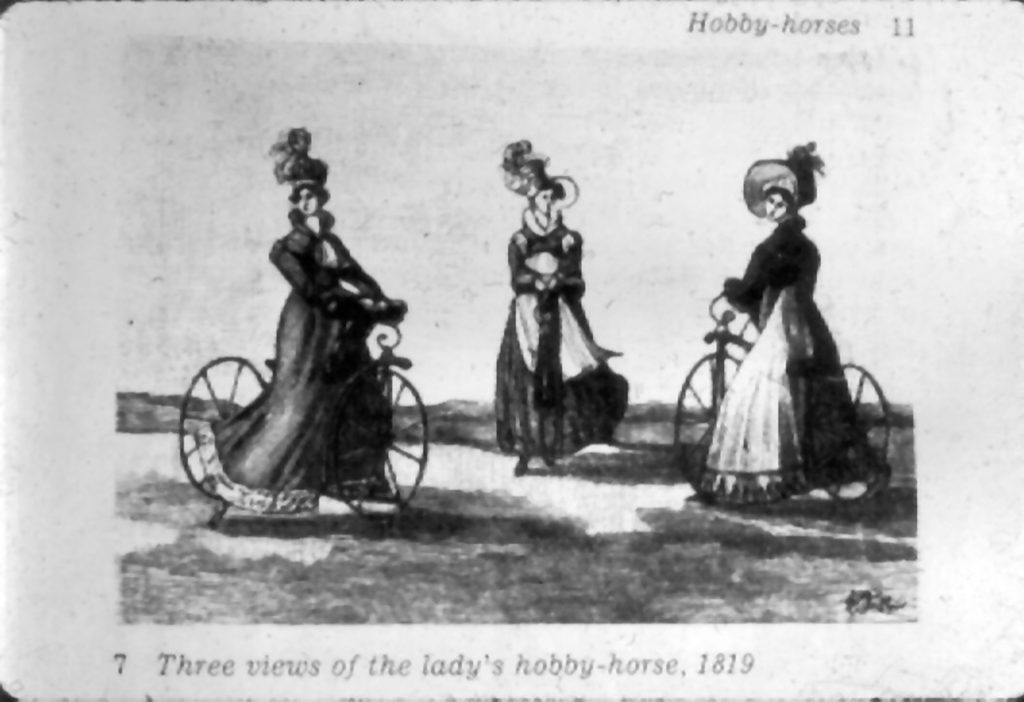
And some did ride the high wheeler and yet it was the safety that ushered in their access to riding and recreation:
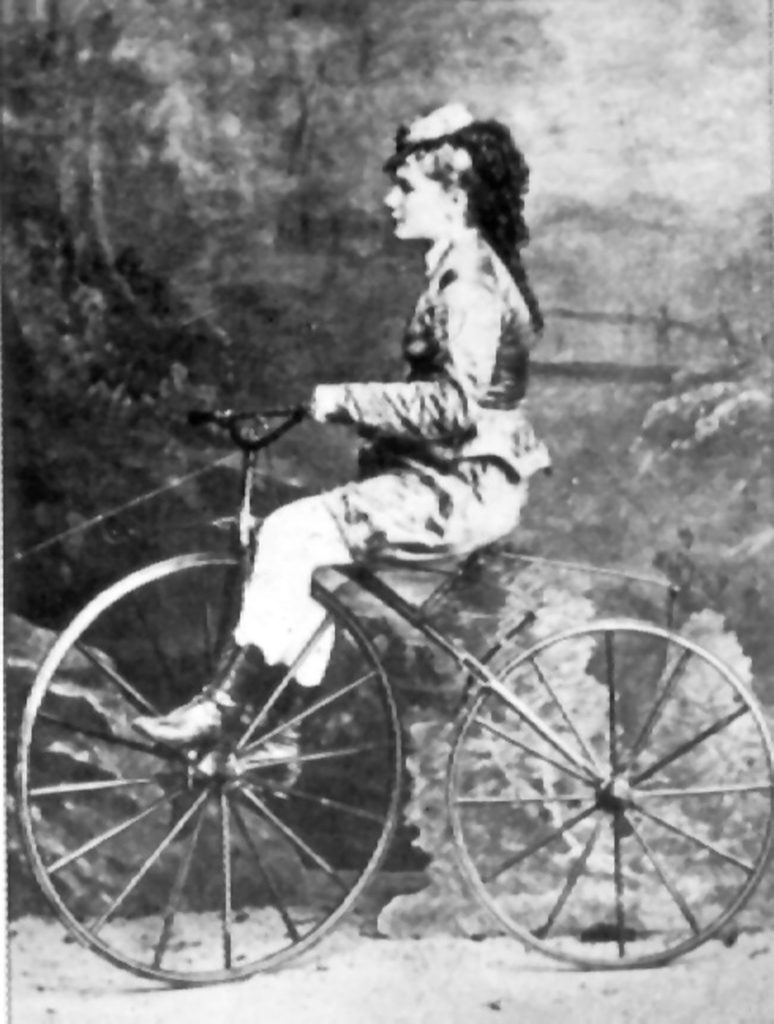
Drop-frame bikes meant easier access…
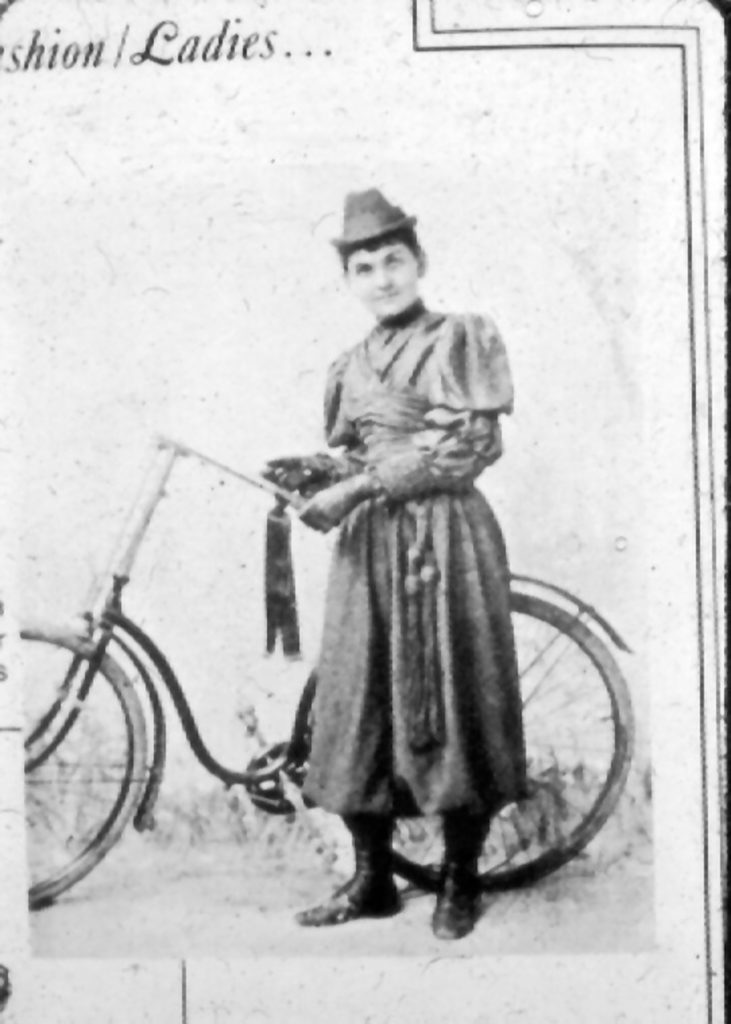
What emanated in single-handed derivation was fashion – the “divided skirt” or bloomers or “bifurcated bags,” as women’s early pants were often described in the media.
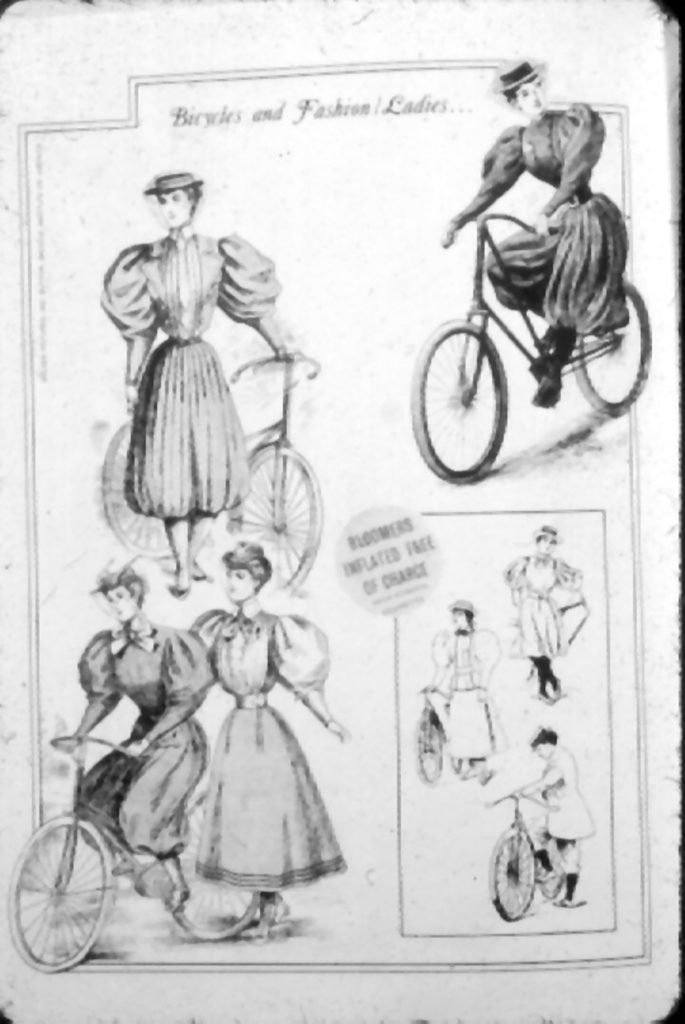
It would have been virtually impossible to ride a bike in full, voluminous skirts although there are some pictures that belie this feat; it is difficult to tell if such images were studio-poses, cropped, edited, and transposed to a painted background – like the one below.
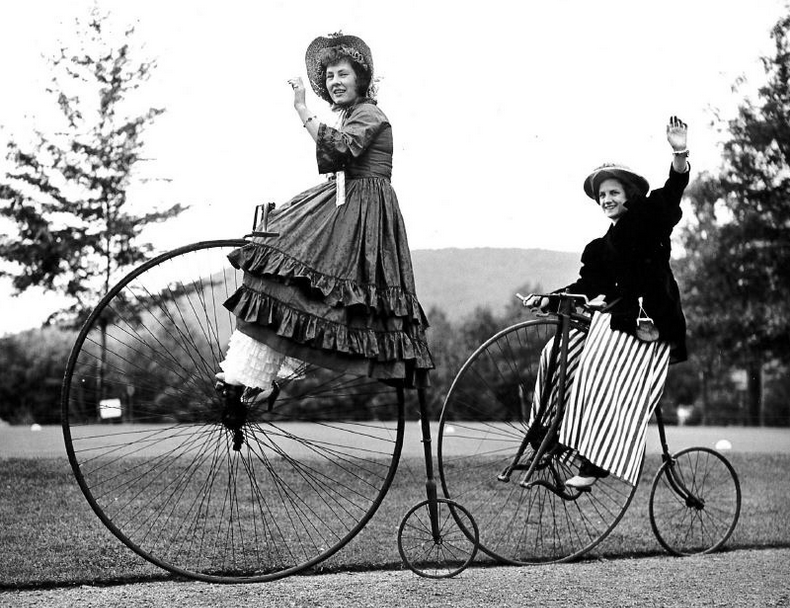
Note the treadle-like, pedal-apparatus on the bike on the right in the image above. Thus, the split-skirt was a direct outcome of needing dress reform, literally, to ride bicycles. As always, satirizing cartoons abounded – note the almost legible, “bloomers inflated free of charge” in the caricature two images above.
By the turn of the century, it was common for women of the upper- and middle-classes to own bikes and become members of bicycle clubs…
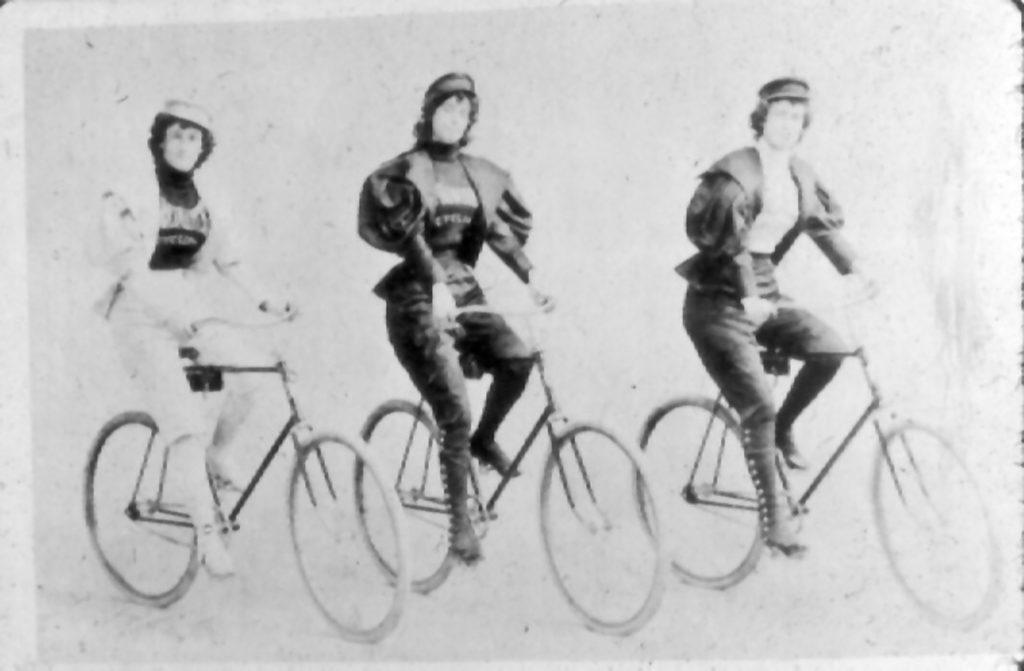
and…
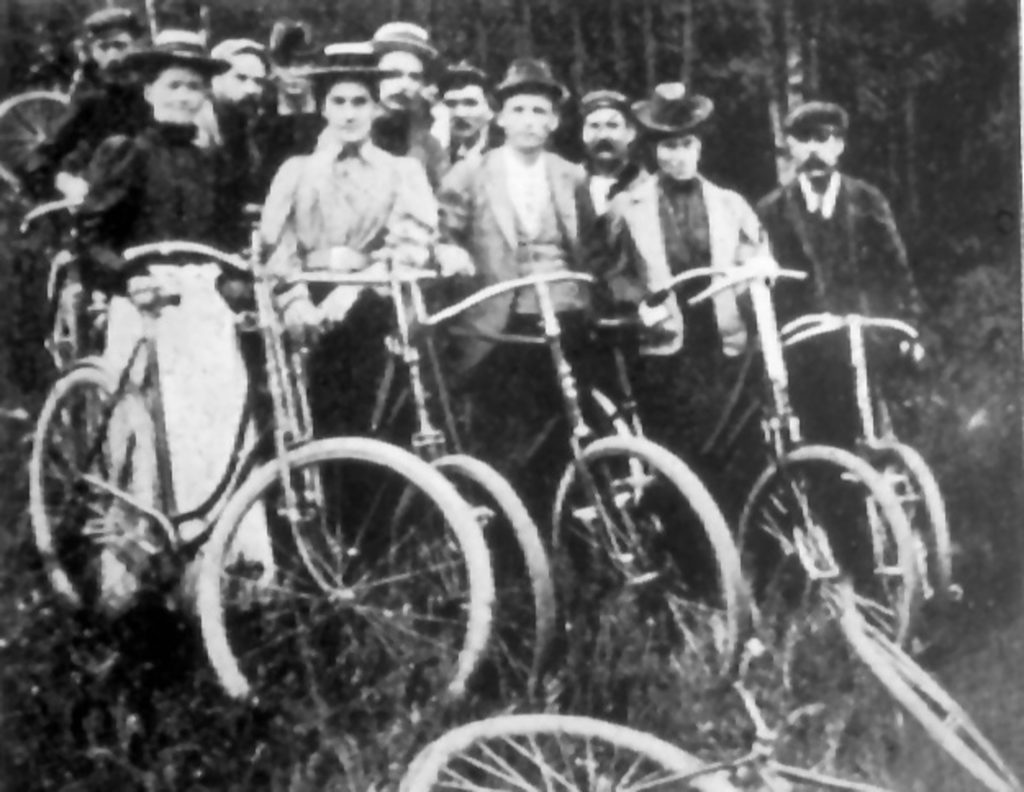
As with the Sociable, the gendered implications likely shook Victorian society:
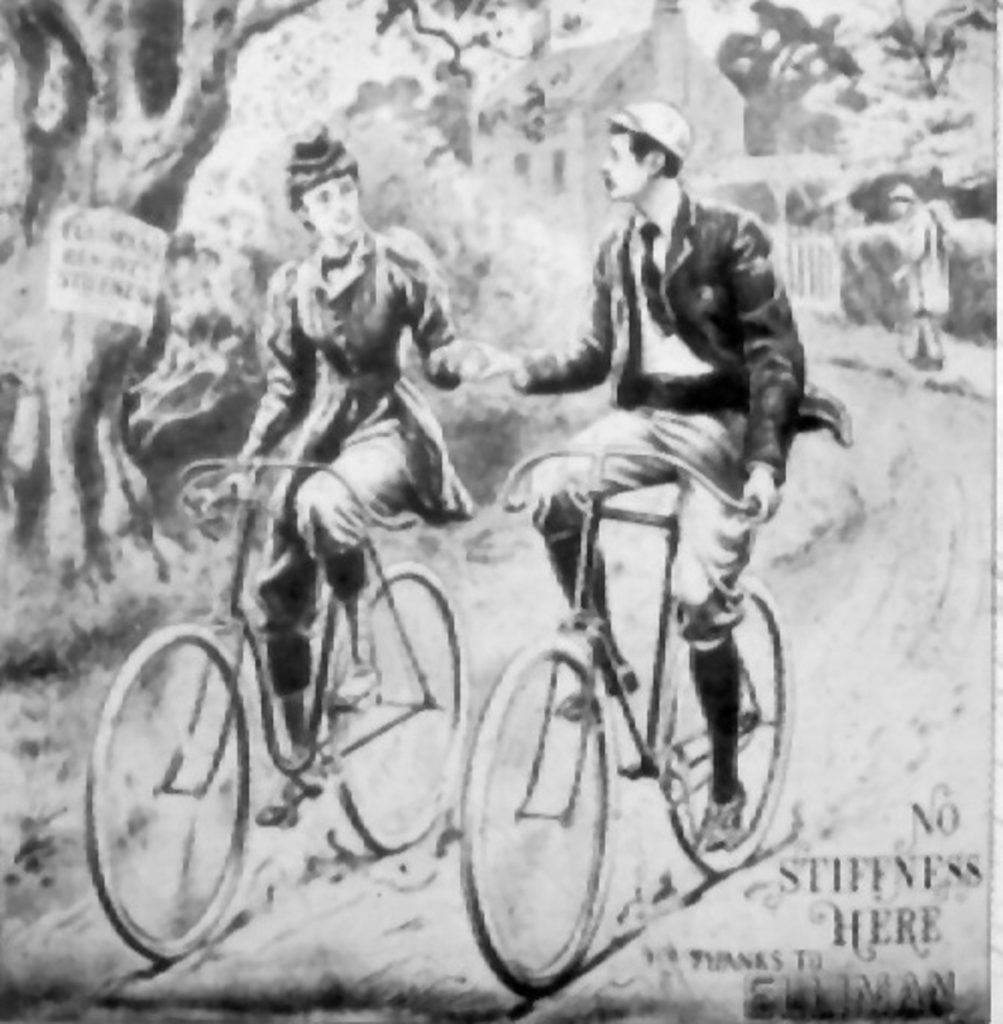
Very likely, this is a liniment advertisement with no sexual implications from the words in the lower right corner.
Without question then, the bicycle was a major factor in women’s dress reform, perhaps even in movement liberation from literally yards of material that restricted movement even in walking. Just viewing a woman or women riding bicycles, passing pedestrians and thereby showcasing the fact that women could move and exercise without the ‘dangers’ the medical establishment often attributed to women who exercised. The bicycle brought an unheard of freedom to women in western society, albeit to the upper echelons of society until much later in the 20th Century.
Bicycles were not cheap; certainly, the high wheelers would have rendered the machines inaccessible to “lower” social strata. The first farthing brought into Canada, at least the one of which I am aware, was one purchased in 1874 from the UK by A.T. Lane; I can’t imagine the import duty let alone the purchase price. However, over the next 25-40 years, as the Industrial Revolution transformed society, mass production of bikes and especially their accessories – bells, lights, baskets, carrying bags, clothing, tool repair kits, part replacements for chains etc., and eventually, pneumatic tires (invented by Dunlop in the late 1880s) – all worked to make bikes more marketable, less costly, and more widely available. CCM, the Canada Cycle and Motor company was founded in 1899 primarily to manufacture bicycles and bicycle equipment.
Most bicycles were for recreation and exercise. However, as noted above, the sporting spirit is restless and riders, becoming more and more proficient, challenged themselves to events like traversing the famous Land’s End (southern point of England) to John o’ Groats (northern point of Scotland), some 1300-1400 km on farthings or high wheelers as early as the 1880s (the world record for doing so still stands at just over 5 days, the feat/feet accomplished in 1886). Similarly, within cycling clubs, century or 100-mile runs were common among the more proficient and zealous riders. Shorter, faster races were common such as this “on the path” caricature on “Ordinaries,” as penny farthings were often called…
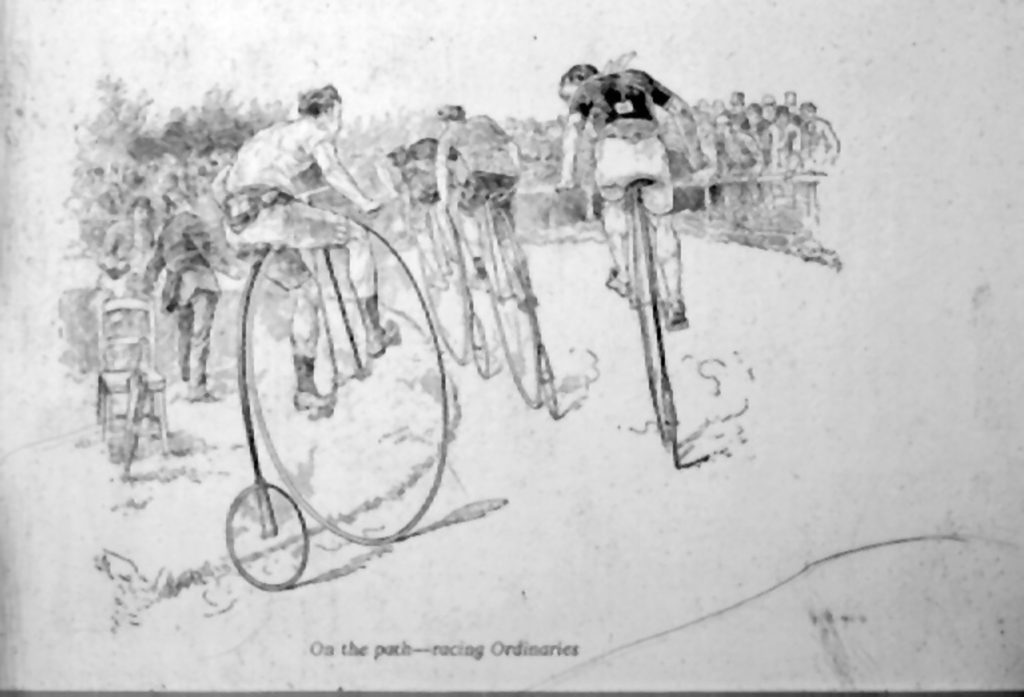
Penny-farthing riding and racing continues to this day – see the youtube link to modern Penny Farthing Racing here.
In the late 19th century, more formal championships, like Canadian ones were held on tracks such as this Montreal Star featured one on the MAAA’s Westmount Grounds around the turn of the century…
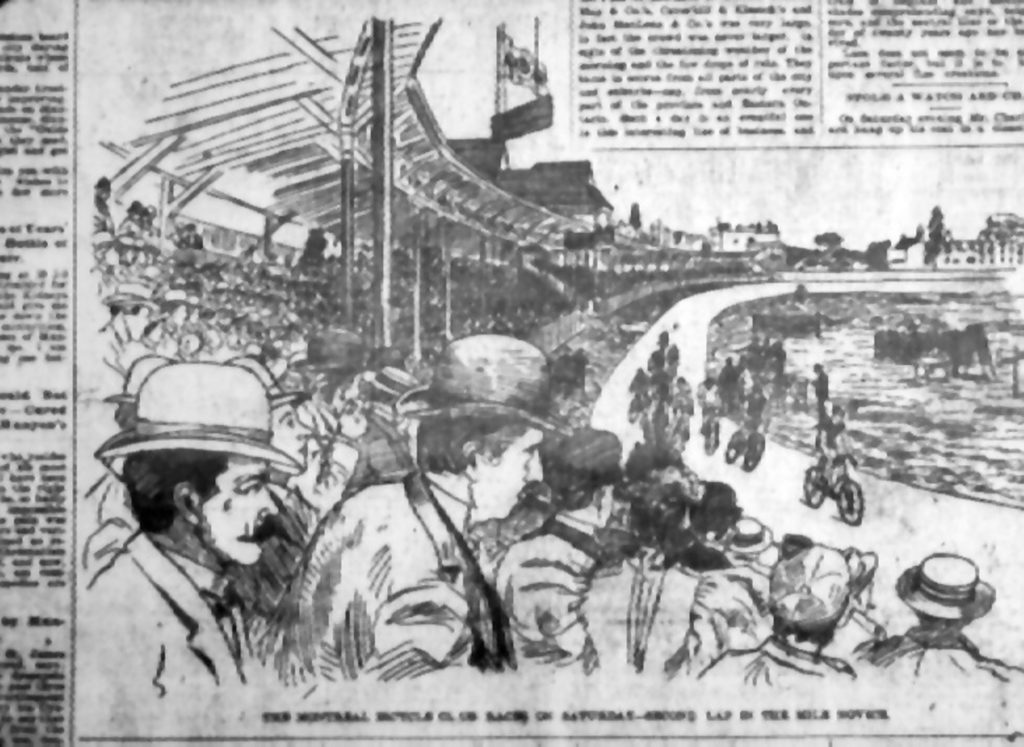
And there was always the argument about relative speed, bikes against horses – humans have faced the same self-induced equine challenge
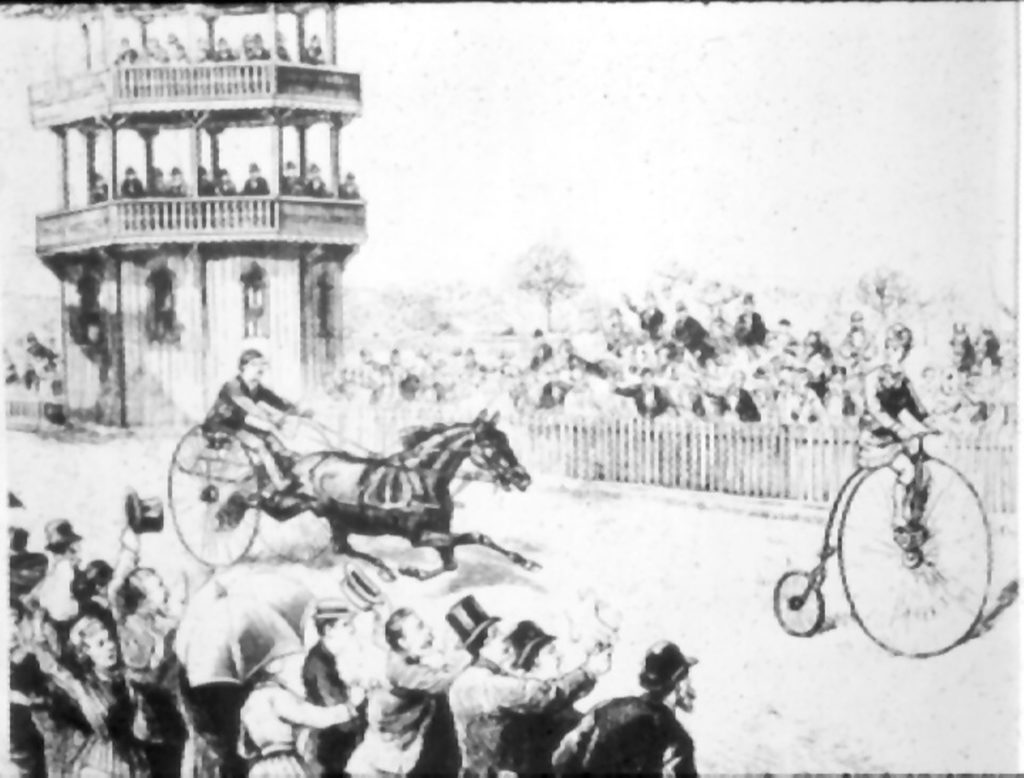
Note the bike rider is apparently a woman; very likely, the rider was given a head start. One can only imagine the rampant gambling at all racing events. When marathon- or long-distance-anything became popular in the 1920s and 1930s, 6-day bicycle ‘races’ were common in Canada. This is a Vancouver Sun ad for one such race in 1931:
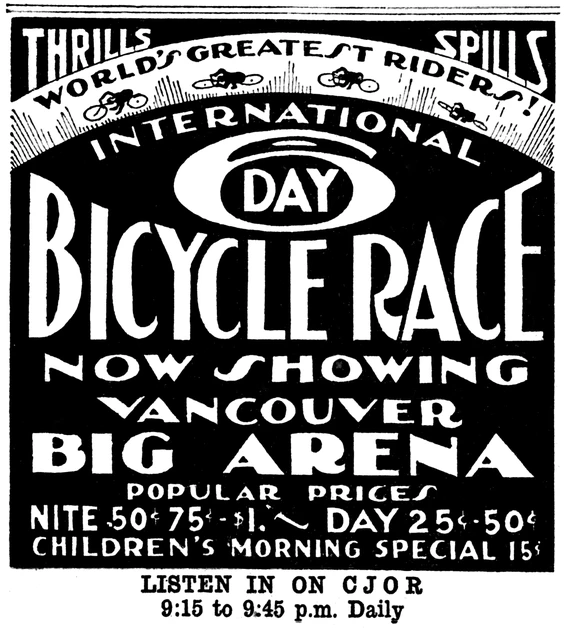
The venue for this one was the Denman Arena wherein a wooden velodrome was built. 6-day events were often at outdoor tracks and there was a circuit of events in different cities across North America; however, the indoor facilities guaranteed paying – and gambling – spectators no matter the weather.
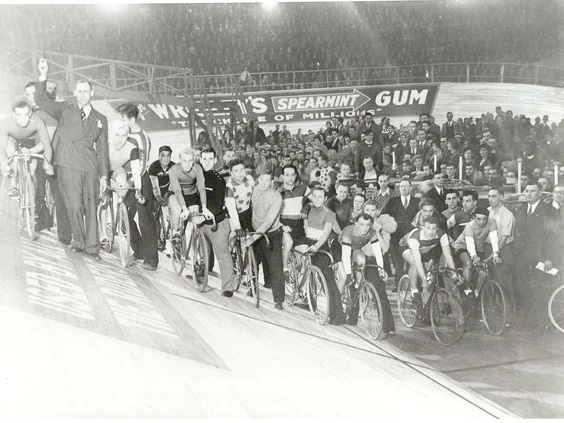
One wonders who counted the laps, how much sleep time was permitted etc. No matter the logistics, these cycling events were kind of the last hurrah of the bicycle craze as the world became more and more enamoured with the convenience and commuting speed of automobiles.
Without question and in spite of all of the pastoral pictures to the contrary, bicycling was an urban phenomenon over its first 50 years of its existence. Commuting was common and racing was always an allure. In the latter regard, in the late 19th and early 20th centuries, in downtown Toronto, the only macadamized area of city streets was the narrow area between street railway tracks. Those paved parts of streets were coveted by cyclists, often to the detriment of pedestrians to the extent that Toronto papers called these areas the “devil’s strips.”
As cars became more affordable, bicycling became more and more perceived as a child’s toy. Ironically, one of the most common frontispiece images in published books on any topic was this one:
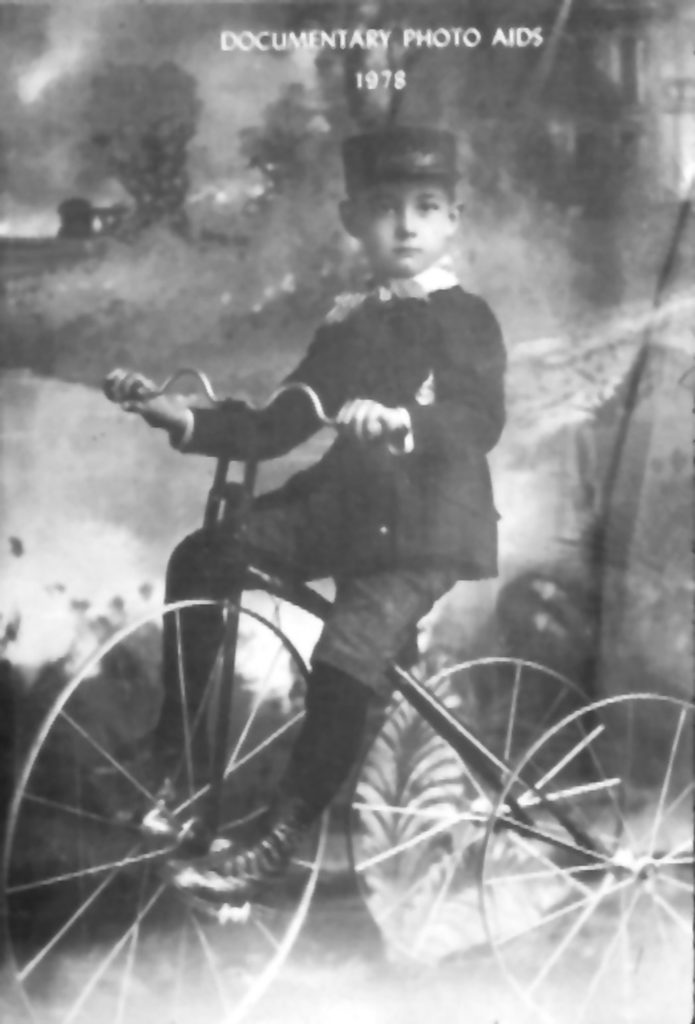
The implication, at least to me, was this was young Canada, as young and Canadian as was the boy – me – on the 1950s tricycle in the very first image in this blog. Cycling and the bicycle have undergone remarkable transformations, resurgences, and overall revitalization of interest for commuting, racing, recreation, and exercise. During the early years of the ongoing Pandemic, for example, it was extremely difficult to purchase a bicycle due to both supply-chain issues and high demand for something safe to do in the face of the need for social-physical distancing. For myself, I like to think there is a genetic connection or bicycle-interest DNA. Our middle son, Joe is a triathlete, having completed several iron-man competitions – ones in which after swimming almost 4 km, then cycling 180 km, he steps off his bike and runs a full marathon, 42.2 km. This is Joe in 2014 triathlon-fit form astride his racing bike:
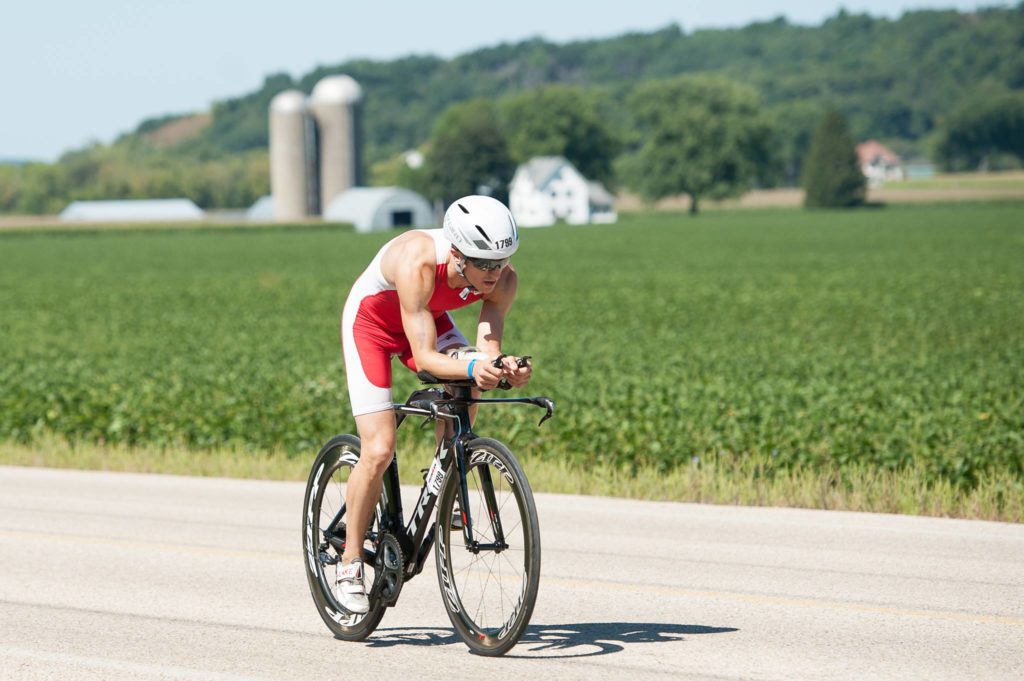
As a former marathon runner, I can’t even imagine doing anything before or after running a marathon, let alone a 180 km bike ride. Our oldest son, Matt makes his living selling adaptive bicycles through his own company, Get Around Bikes. Apropos of the bike forms and innovations from 100 years ago, it is so interesting to see the variations in bikes, like these ones shown on Matt’s site . . .

And, in Matt’s showroom isn’t the bike on the left such a modern derivation of the Sociable . . .
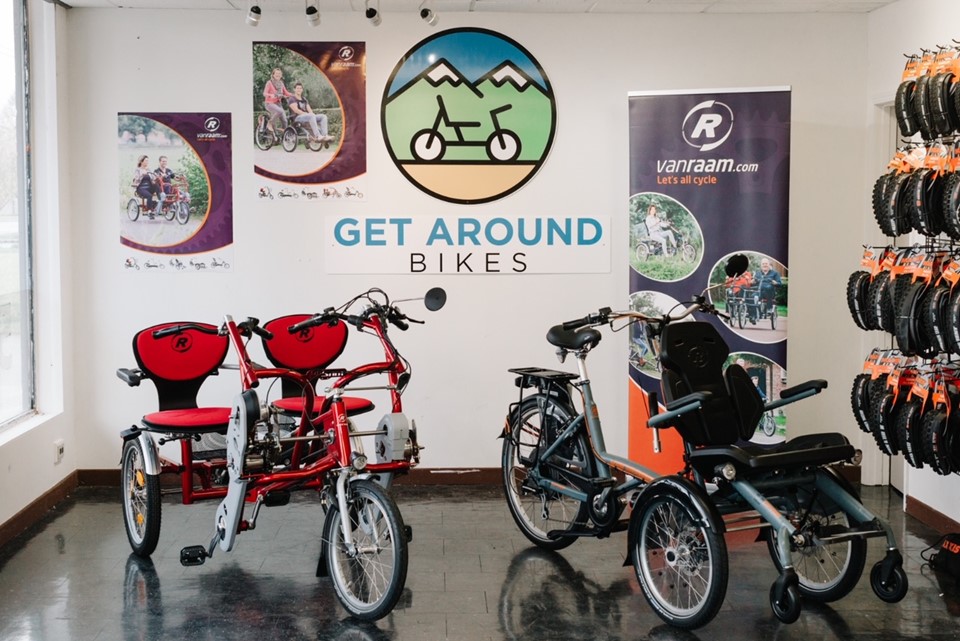
Matt doing what Matt does superbly – the affable, genial salesperson interacting with customers who are seated in and on a contemporary rear-steering tandem tricycle:
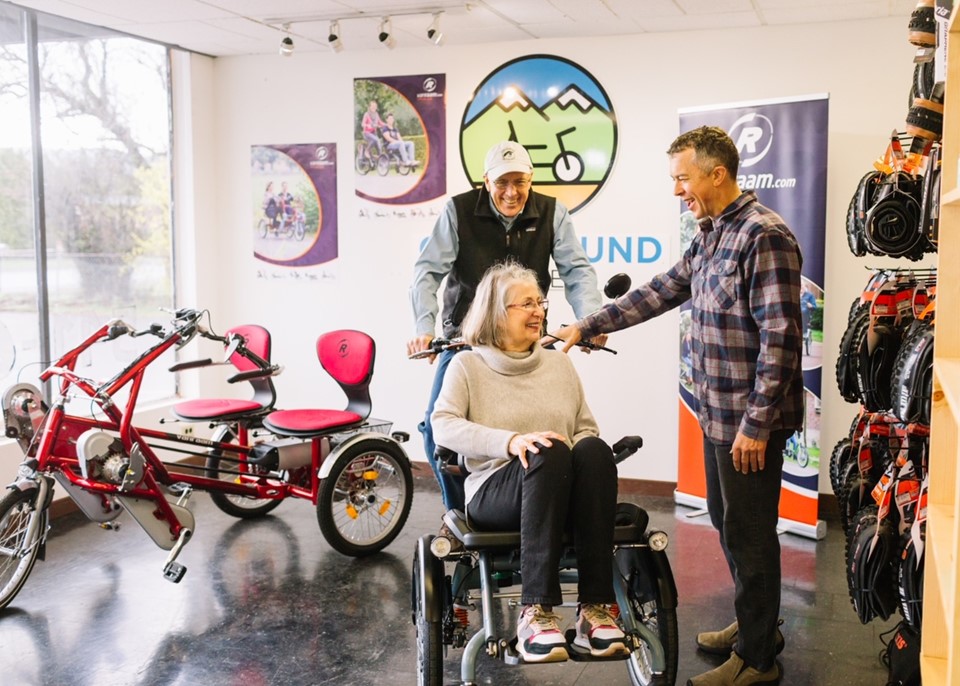
In the same vein, Matt’s passion for what he does and the concept – getting around, not bikes – is evident in his “About Us” credo:
“We provide mobility and freedom to those who need adaptive bicycles. Many of the people who contact us have never had the opportunity to ride a bike or they once were able to but now have a need for an adaptive bike. We love seeing the smile that cycling brings to each one of our customer’s faces. It fuels us. Get Around Bikes was born to give people of all ages and abilities the exhilaration and positive benefits of cycling.”
Recently, The New Yorker magazine published an article called “Easy Rider” (print version) and “Bicycles Have Evolved. Have We” (online version) by Jill Lepore. In the piece, there is some mention of bicycle history and her focus is more on the present; she claims “bicycles are the world’s vehicle of choice, with one bike for every four people on earth – two for every car.” Her piece has a wonderful illustration by Carl Vander Yacht that shows the various ‘evolutions’ of the bicycle over time:
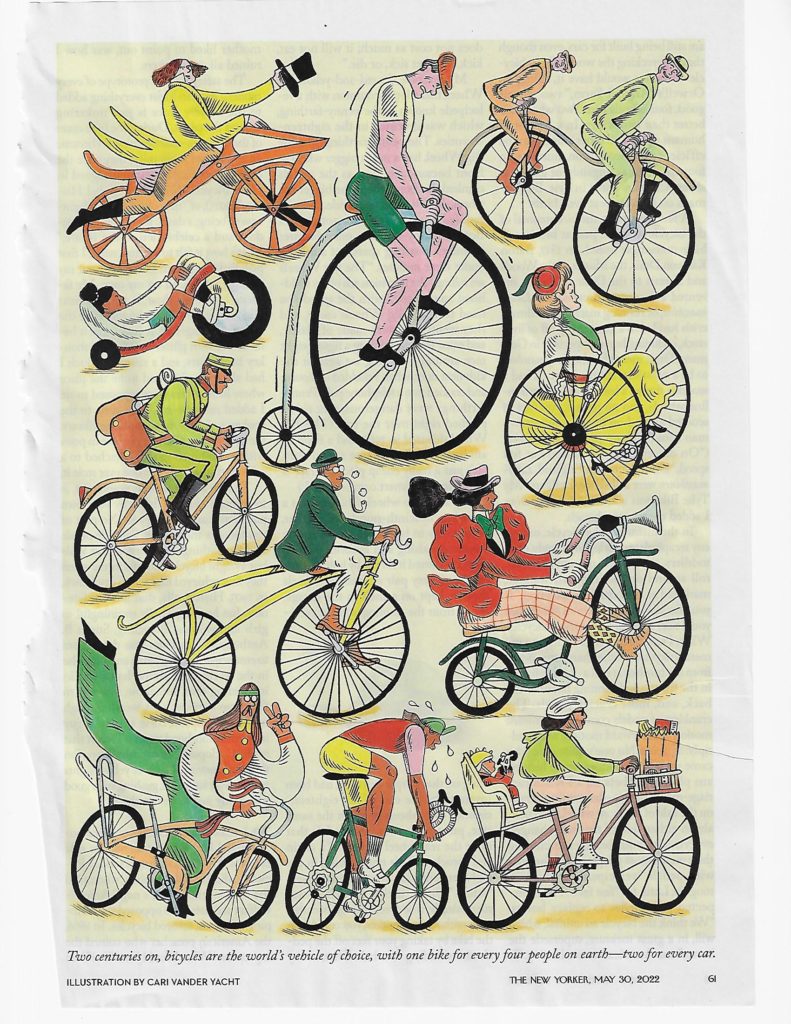
Thus, my lifelong fascination with the bicycle endures in all manner of forms. Consider how institutionalized the bicycle is in the idiom, “it’s just like riding a bike” – a kind of universal reference to the notion of once you learn how to do something you never forget it. My interest in the living history of the bicycle remains steadfast. Each time I cycle, in many respects, I ‘ride history’ and I tumble home to my lifelong personal and professional enchantment with its history and its social and societal impacts.
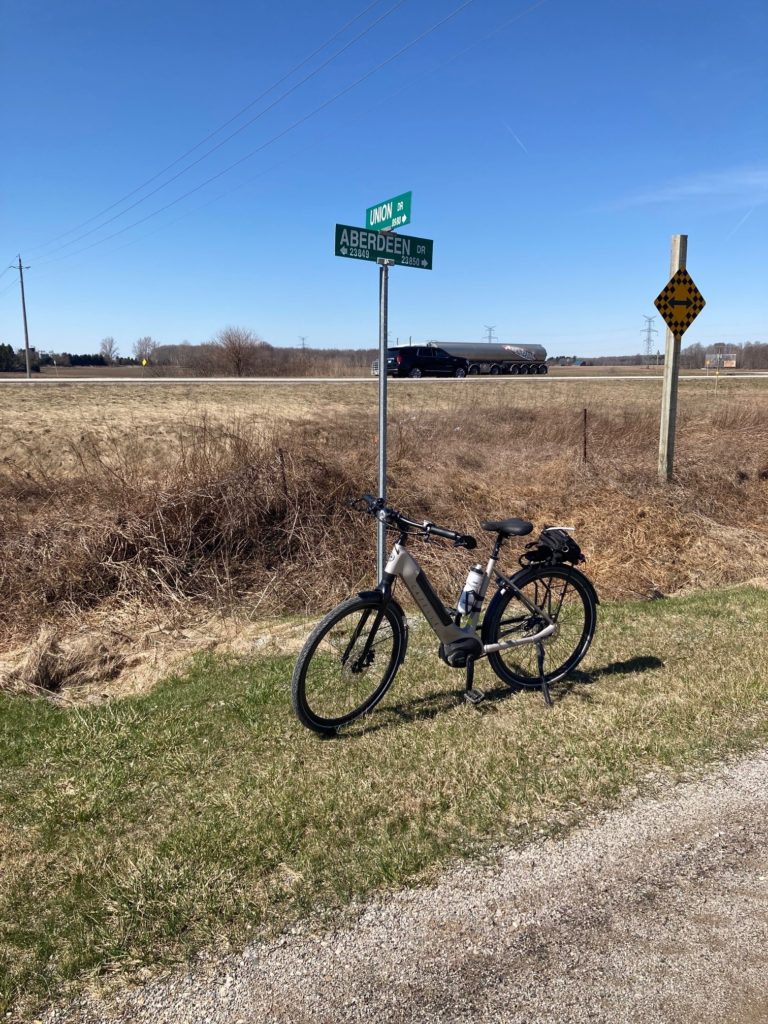
Above: My Gazelle Ultimate C80 at rest half-way through a 40 km ride. Below: the most current, imaginative iteration of the bicycle with a treadmill device . . .
